
1986

I left St. John's on August 20, stopping briefly in Toronto to visit Ann Wilson and Ginny Rochester. I stayed overnight at Teri Snelgrove's place in Vancouver. She had just moved there from St. John's. I slept in a room that Beni Malone, the Newfoundland clown was using. He was on tour somewhere in BC. After many years in the West Coast film world, in 2019, Teri was appointed Producer at the Vancouver-based production unit of the National Film Board of Canada.
I stayed overnight in Hong Kong at the YMCA in Kowloon. Rode the Star Ferry to the Hong Kong Island, 5 cent ticket.
I arrived in Beijing Aug. 23 at 5:00 pm. Lan Jian was there to meet me and help me get take the train to Tianjin about 115km away as the crow flies. I had heavy bags - suitcases with wheels weren’t invented yet. They were loaded with books, mostly about architecture. I also brought a set of tapes of a series of lectures called “A Sense of Place” by the architect, Robert Stern, and a TV series on China called “The Heart of the Dragon”, made by the BBC. Noel Flynn, in St. John’s taped it for me. The immigration officials were not sure they could allow these videos into China. They asked whether someone was there to meet me. I told him a Tianjin University student called, Lan Jian, should be just outside. The official went out and came back with Lan Jian. He assured the official the videos were purely educational in nature, and I was allowed to bring them in.
I had two 70-pound bags of books, a shoulder bag and a ghetto blaster. The plaza in front of the Beijing Railway Station was so crowded, cars were kept away. The taxi could only get within about 70 meters of the entrance and was blocked by a metal fence. The taxi driver and I lifted the bags over the fence and Jack caught them on the other side. Lan Jian bought some food; a roasted chicken complete with head and feet, and a bag of sweet buns.
Time to move. Lan Jian asked a man to help us. One suitcase jerked into the air and onto the man's back. I followed this blue suitcase, through crowds standing and sitting, up giant escalators to a large hall. On both sides were gates to trains heading to many other cities.
Lan Jian dragged the other suitcase over the terrazzo floor. We had two minutes. Our helper raced out of sight weaving his way to the other end of the train, to the soft-seat car. Lan Jian was getting tired. He quickly negotiated a price, giving the man half what he had asked for. We sat down, stripped off our drenched shirts and tried to cool off. Two and half hours later we were in Tianjin.
At the Tianjin station we leap-frogged the bags keeping them in sight of each other until we could get a taxi. It was late. The Tianjin University No. 1 Guest House (or Foreign Experts Building) was closed. Lan Jian woke up the caretaker. He let us in and lifted one of the suitcases onto his back. Lan Jian and the taxi driver, together, carried the other bag. I took care of the shoulder bag and the ghetto blaster. We all climbed stairs to the fourth floor to Room 403, my new home. For the study program last year I lived in a shared room with a bathroom in Building 22; now I had my own one-bedroom flat with a private bath room. The tub was so long you could lie down in it.
I said goodbye to Lan Jian and put a cassette, Butterfly Lovers, into the ghetto blaster,
The music told the story of a young couple denied permission to marry, The lovers commit suicide together and turn into butterflies. I put my books into the bookcase. After all that trouble, they don't look like so many.
I am the third foreign guest professor of architecture at the School of Architecture. The first was Tony from America, the second a Japanese woman. I had no experience teaching design; I felt intimidated being referred to as an 'expert'.
My contract included a salary, accommodation, and one return air ticket to Canada. The starting salary was 600 yuan/month, in those days, about $250.00 Canadian; low by Canadian standards, but double a local salary. Others who had been elevated to the status of Foreign ‘Expert’ were mostly young American English teachers with strong Christian beliefs. We shared a dining hall on the main floor beside the lobby.
The next day Prof. Jin Qi Min came to see me. I was happy to see him again. He was warm-hearted, a talented architect, a dedicated teacher with wide experience, and had an eye on the future. He will attend a meeting on architectural education at UNESCO in Paris in October. He explained I would be teaching in the 3rd and 4th year studios in Building 8. I will have fifteen students from each year and an assistant. My students are the ones who can speak some English. The fourth year students will design a gymnasium for the upcoming 1990 Asian Games.
Over the next few days I reconnected with people I had met last year. Zhang Chi (张敕),Vice-Head of School of Architecture and 张弛 “Cary”, a recent graduate and now a young teacher, helped me buy a bicycle, for 160RMB, in a market near the French Concession Catholic Church. Most bicycles looked alike, black colour and sturdy with a heavy duty rear-passenger seat. It comes from the factory assembled but not tightened. Part of the purchase procedure is a thorough checking and tightening. Zhang Chi helped me get a license for the bicycle and took me to a photographer. Various Chinese documents and ID require photos. They took two different shots and asked me to come in 10 days to choose th one I like best. Cary also agreed to help me find a tape player and monitor so we could watch the video tapes I had brought from Canada.
I met Zhu Jian Fei again. Yu Mao Lin called me in my room. When I picked up the phone, he said, “Joe Carter’s voice? Are you convenient?”, a literal translation of what one says in Chinese. Liu De Fu came to welcome me. She explained my salary and living arrangements. I will be paid half in RMB and half in US dollars. Zhou Zu Shi visited to talk about how I could help his Architectural English class.
August 27
The Fall Design Studios began. I was introduced to the fourth year class. My co-teachers were Zhang Chi (Cary), Sheng Kai, Xu Su Bin, Li Jie, and He Jian Qing (Jeanette). The studio teaching method was similar to what I had experienced at McGill with some differences. The room, instead of a carnival of individual personalized spaces, each with desk and storage unit, was a large classroom with five neat rows of drawing board-sized tables. The teachers, instead of roaming the whole room, were each assigned to one of the five rows. I met my first group of students; a ripple of nervous shy glances. I never knew how I had been assigned to this particular group; perhaps their English was a little better. I knew only a few words of Chinese. Language was not much of an issue because teaching was not “lectures”; it was moving from desk to desk looking at the work of the students one at a time. My language was drawing. At each desk, I would take a piece of tracing paper, put it over the student’s work and express with sketches, my questions and suggestions. When we were really stuck for a word, they would call the star English student in the class, a very tall girl, to come and translate for a few minutes. They had had Tony Vachionne as a teacher before. They laughed when they told me his favorite word to describe their work was “luanqibaozao” (乱七八糟). The literal translation was “chaos-seven-eight-messy”; in other words, “chaotic”. Chaos in the West occurred when things were “at sixes and sevens”, not sevens and eights. After millennia of separation, we were only off by one.
Most of my students did not have English names. Many English teachers gave them names. One of the English teachers told me when the students choose by themselves they came up with names such as: Nixon, Reagan, and Dostoevsky. Wanting to respect Chinese culture, one teacher tried to learn his students Chinese names. He pronounced one girl's name, Zhang Wen Zi, as Zang Wen Zi. With his poor Chinese pronunciation, he was calling her a 'dirty mosquito'. The student protested, "Please call me by my English name".
My third year students were: Zhang Hong Hong, Li Qian Mei, Luo Feng, Dong Qing, Zhang Yi Xin, Guan Wei, and Yu Xue Mei.

With my students (I am behind the shortest girl)
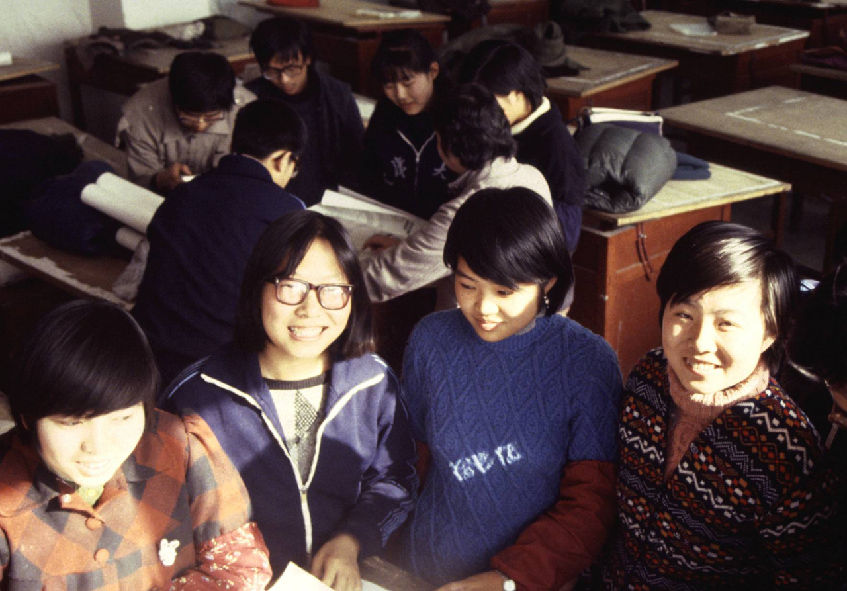
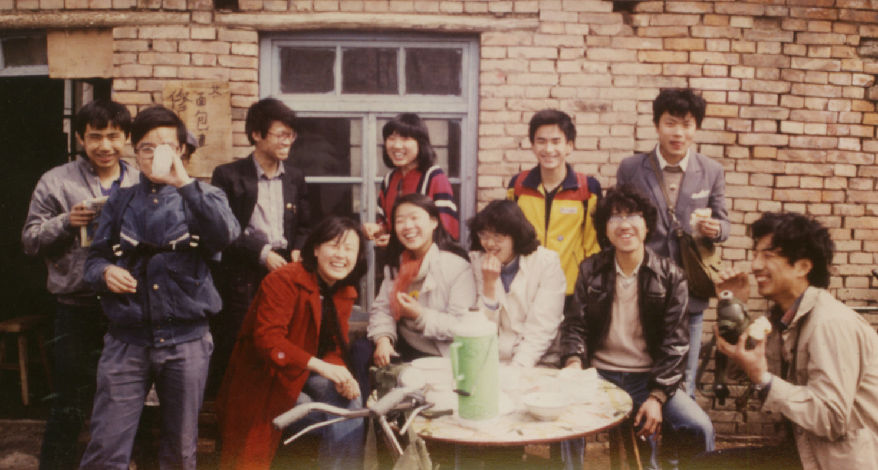
My fourth year students were: Li Hong, Li Yan, Huo Guang, Wang Yue, Chao Dan Ting, Cai Chao, Yan Zhou Jun, Qian Fang, Zhao Fan Pei, Liu Yun Yue, and Pan Zi Ling.
Some of the older teachers showed the students how to design by doing some of their design for them. The younger teachers - and although I was 39 years old, I included myself in that group - were more inclined to encourage the students to try first on their own and then offer comments. I once asked a student, as we were looking at his work, “Well, what do you think?” The student hesitated, then said, “But, you are the teacher.”

Student Design

Student Design

Student Design
August 28
Cary took me to see the Hyatt Hotel on Jie Fang Lu. Construction was almost complete. The hotel is intended for foreigners and overseas Chinese. It's a 19-story building, on a four-story street designed with obvious Chinese references. This was an approach to design that faded over the next 20 or 30 years. I asked the man taking us around about the five star standard of the hotel. It was jarring after what I had seen so far. He said, "Leaders wealthy, then merchants wealthy, then all the people". I believe it is currently the tallest building in Tianjin.
August 29
Go with Yu Maolin to visit the Tianjin Design Institute. I saw proposals for the Shanxi Mining College and the Tianjin Financial Management College.
Margaret, one of the English teachers, can speak, read and write Chinese. I envy her. She gave me a Chinese lesson about tones.
Outside my window pigeons fly in large group in a large, 17-second, circle. They share a large cage at their owners home. Some wear whistles on their legs and the droning revolves overhead.
I dreamed last night I was explaining to someone, with a loud voice so Dad could hear, that my poverty was 80% my own choice and 20% circumstance. He has said to me in Ottawa these are your prime earning years.
August 30
In the morning, Cary accompanied me to the photography studio. I had forgotten my receipt, Cary was sure that without it we could not see the two test pictures they had done. Fortunately, a kind and patient women, knowing the date and number of prints I had requested flipped through a couple of hundred little envelopes until she found mine. I chose what I thought was the better picture. In ten days I should come back for my copies. I ordered ten. Mostly they are for the Foreign Affairs Office.

The one not so good
In the afternoon Margaret and I took the No. 8 bus to the Train Station and walked back to the University from there. We crossed the Jie Fang (Liberation) Bridge, went along Jiefang Lu (Liberation Street) and wove our way through interesting, very intact, Concession Area streets.
Everything built by the colonizing foreigners with an attitude of we are here forever.
In the evening I washed a watermelon in my bathtub and ate it.
August 31
Look through my books to see whether I have anything helpful for Xu Subin on the subject of Architecture and Psychology.
Start thinking about how to present my CIDA Housing Research work here.
September 1
Early morning:
A horse galloping in slow motion through tall wheat fields; a soundtrack for this image creeps into the morning silence. Followed by swing-your-arms, lilting marching music. Peppered by Fred the Rooster in the neighbour's backyard below my window. Followed by announcements pouring from loudspeakers spread around campus and commands for morning calisthenics: "yi, er, san, si, - wu, liu, qi, ba, (1, 2, 3, 4 - 5, 6, 7, 8), repeat, repeat.
A teacher with an Olympic Torch hairdo was walking on campus. She heard a big crash. She turned to see two Chinese women sprawled on the ground entwined with their bicycles. They had been looking at the 'flame' and not at each other.
Powerful electric storm last night.
Look at English books in Architecture Department Library. Met Nie Lan Sheng there. She grew up in northeast China when it was occupied by Japan, and speaks Japanese. She said there is a Women's Architecture Design group in Beijing.
I learned a commonly used Chinese phrase, "Bu Yao Ke Qi" (Don't have guest spirit), "Make your self at home".
September 3
First day of studio
Fourth year students are working on a gymnasium - a building type I know little about. I recalled a comment by Sheila Gostick, a Canadian Comedian. "Why make these big spaces that are mostly for men? Why not have some for women? They could be large birthing arenas." I keep these thoughts to myself.
The main characteristic of this building type is its large-span roof structure. Although I was called a “Foreign Expert” I had little experience with this scale of structural design.
September 5
In the evening I went with Margaret and Andrea to Food Street near the old city. We passed a mosque where they had just finished a service. A funeral procession went by, people wore white suits. The coffin had no side walls. At the foot was an Islamic inscription.
September 6
The class went to the Tianjin port area called Tongu to look at a new 3600 seat gymnasium.
That evening a student called Jin Li Qiang came to visit with his brother. His brother had forgotten his ID so our guard, the old man, would not let him come up. I felt angry...like a prisoner. Li Qing left his bother downstairs, came up, borrowed a few books and ten minutes later left.
September 8
The disc jockey for this morning's campus loudspeaker music had chosen the song "Land of Hope and Glory". This is a British patriotic song, with music by Edward Elgar and lyrics by A. C. Benson, written in 1902. It's chorus says:
Land of hope and glory, mother of the free How shall we extol thee, who are born of thee? Wider still and wider shall thy bounds be set God, who made thee mighty, make thee mightier yet God, who made thee mighty, make thee mightier yet
I wonder whether the person who chose the song knew it was the anthem of a colonial empire, claiming to be the mother of the free, that made its boundaries wider still by invading and occupying parts of China?
I met the new teacher who had just arrived to stay in our Guest House. We were now ten Americans and 2 two Canadians. The new person asked me what state I was from. My prejudices were flushed out. These chirping, smiling people whose lives are full of privilege, who's views are strongly ethnocentric, and who never seem to have suffered, test my patience. Why do I feel this?
September 9
Sometimes for breakfast I go out and buy Jian Bing Guoze, a thin egg-pancake, for 40 cents at a vendor on campus.
I collected my photos from the photography shop and brought five of them to 'Susan' at the Foreign Affairs Office. She wants a sixth one. I went back to the Guest House and got the photo. As I left the Foreign Affairs Office, my bike peddle fell apart. I went to the campus bicycle repair place. They repaired the peddle and did another overall tightening.
Later, another great talk with Zhu Jian Fei about science, religion and civilization.
September 11
In the evening I helped Yu Maolin with his design for the campus of the Provincial Mining College.
September 12
Attended a staff meeting. Cary helped translate.
Long talk with Xu Subin. She had visited a poor village in Anhui to do research about fengshui. She saw Japanese people there doing measured drawings.
September 13
I broke the 4th year students into five small groups to work on aspects of the gymnasium design. Regrouped later to share results. I invited them to visit me in the Guest House any time.
Jin Qi Min gave me some positive comments about my CIDA research plan.
September 14
Wonderful day with Xu Su Bin. Talked about world views and belief systems, and their outer expression in architecture and city planning. She had been nervous about coming to the Guest House; afraid of being criticized for being too close to foreigners. We went to the Da Bie Buddhist Temple and talked to a monk and to the Mosque where we spoke with an Imam. He was a Haji; he had made the pilgrimage to Mecca. The Mosque is just outside the old city wall.
Evening: one student from 4th year and two graduate students came to visit me to talk about their work.
September 15
Worked on an Information brochure and registration form, in English, for an International Symposium on Traditional Dwellings and Lifestyles sponsored by the Department of Architecture to be held next year in July.
Prepared for the first class of Architectural English. Prof. Zhou wants me to be the teacher. The first lesson in the text book is about pagodas.
Evening: two students from my 4th year group, and one who was not, came to visit me to talk about their work.
September 16
AM Help Qiu Kang with his thesis
PM Help Xu Su Bin with her thesis. She knows so much and is finding it difficult to focus. She came 40 minutes later than our agreed time (just after lunch) because she thought I might take a nap after lunch (which many Chinese people do).
* * *
In addition to studio teaching I taught Architectural English, once a week. Professor Zhou Zu Shi gave the class before; now he sat and listened to me.

Lin Ning was his graduate student assistant. Her English was the best of anyone in the Department. “How did you learn to speak English so well?” I asked her. “I had some records”, she said “that I played on the phonograph, over and over until I had memorized them.”
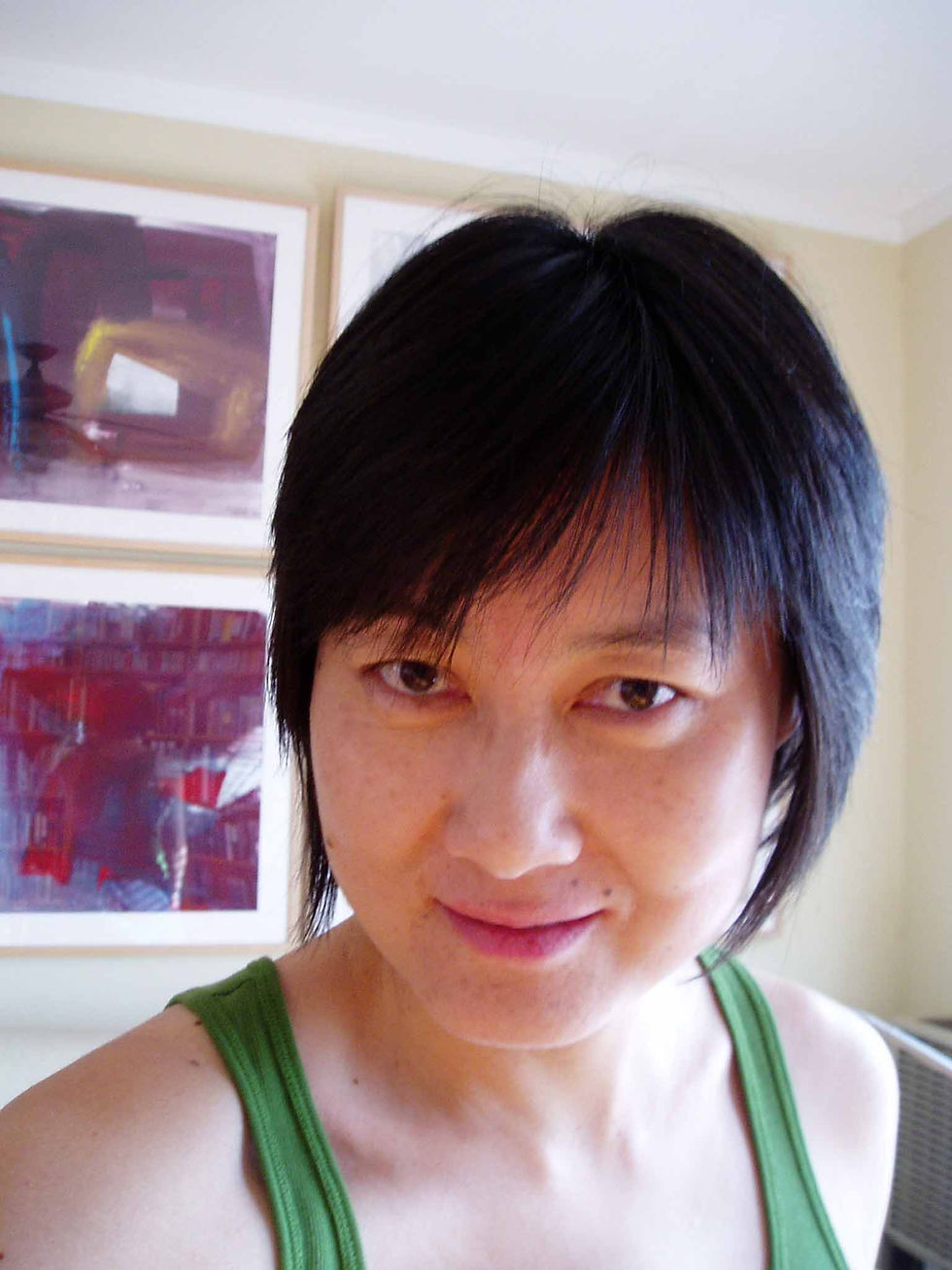
Li Ning
The course text book was a collection of articles, each with one illustration and a brief English-Chinese “dictionary” of more difficult words. The subject matter was not very interesting and was out-of-date. I used it for a few weeks until I could prepare better materials. Using the books and magazines I had brought from Canada, I made a set of A3-size handouts. On one side of the page was the article and a few illustrations, and on the other, a dictionary with difficult words translated by Lin Ning. Professor Zhou approved, and we set aside the old textbook.
The class was two hours long and large, about 100 students. I had to throw my voice to the back of the class. I explained ideas and words with sketches on the blackboard. The board was black, not green, and the chalk was white, not yellow. At the end of the class I needed a shower to clean off the dust. To make the class more interesting, I asked different students to read a few lines; and sometimes played a translation game. I passed out 20 quotations, one for each group of 5 or so students. All their lives they sat in rows listening; this exercise was designed to let them move around a little and let them work in groups. The five students, together, would translate their English quote into Chinese onto a separate piece of paper. When everyone was done, I collected both the original English quotes and the Chinese translations. Then I gave each group a Chinese translated quote, but translated by a different group. Their next task was to translate the Chinese back into English. When they had finished, I gave them the original English quotation. They enthusiastically grabbed them to see how closely the twice-translated quote was to the original.
One day as the students were getting into their seats a girl seated in the front row had a clear plastic bag full of corn kernels. I asked her what they were for. She said, in English, “Teacher, this is medicine for the mouse.” I was feeling sorry for her sick mouse until another student helped me understand that the university was having an anti-rat campaign. The word for “poison” and “medicine” is the same in Chinese.
Once I tried a spelling bee, but only once. I asked all the students to stand up against the wall. It was hard to get them unglued from their chairs, but finally they were arranged like nervous bats fluttering on three sides of the room. I told them I would ask them to spell a word, and if they made a mistake they had to sit down. The last one standing was the winner. My competition-infected activity was rubbing up against the Chinese collective sense, against 2000 years of a Mahayana Buddhist-inspired social trait, “No-one wins unless we all win”. As I asked individuals around the room to spell words, back-up whispers that I could barely detect allowed everyone to answer correctly. There would be no-one to sit shame-faced alone in the empty seats. End of experiment.
After class, Prof. Zhou Zu Shi and I were heading in the same direction so we walked together and chatted. Tall poplars rattled their big leaves overhead and sprinkled shadows on the bare earth that covered most of the campus. I think he was amused by my attempt - failed attempt - to liven up the class, but he said nothing. He spoke of his youth, as a soldier, in North Korea, fighting the US, UN, and ROK forces. I told him about my uncle who had been part of the UN force. I said, “Maybe, you two saw each other?” He laughed; nice to be on a new footing.
I was hoping I could use the Robert Stern tapes in class, but it was very difficult to get a tape player. The whole university only had a few, and they were kept under lock and key. Cary came with me once to check whether my tapes were playable. The space in the room with audio-visual equipment was behind a large folding metal lattice gate with a padlock. My tapes were playable, but it was not easy for the Department of Architecture to borrow equipment.
* * *
September 17
In the studio a student asked in English, "Teacher, how should we call you politely?" I appreciated this courtesy embbedded in the culture.
Architectural English Class. A large square classroom with long rows of connected wood desks with loud folding benches. There are about 100 students and I have to raise my voice to get to the back of the class. I asked some of them to read and they all did it well.
Seven students came to visit and talk about their work. They invited me to a dance tomorrow night. Three of them left me some moon cakes.
September 18
Moon Festival. I should look at the full moon tonight and think of my parents
My bother, Chis, is getting married to Vicky Snarr. I have a gift to send them, Chinese cushion covers.
PM: Xu Su Bin came with me to the Post Office to help me mail the package. Customs has to see the contents first and then we must sew it into a bag. She asked whether after I graduated I could chose where I worked. In China the students are assigned to a work place.
We visited the Austro-Hungarian Concession and entered the former home of Yuan Shi Kai
(1859 – 1916) a Chinese military and government official who rose to power during the late Qing dynasty, becoming the Emperor of the Empire of China (1915–1916).
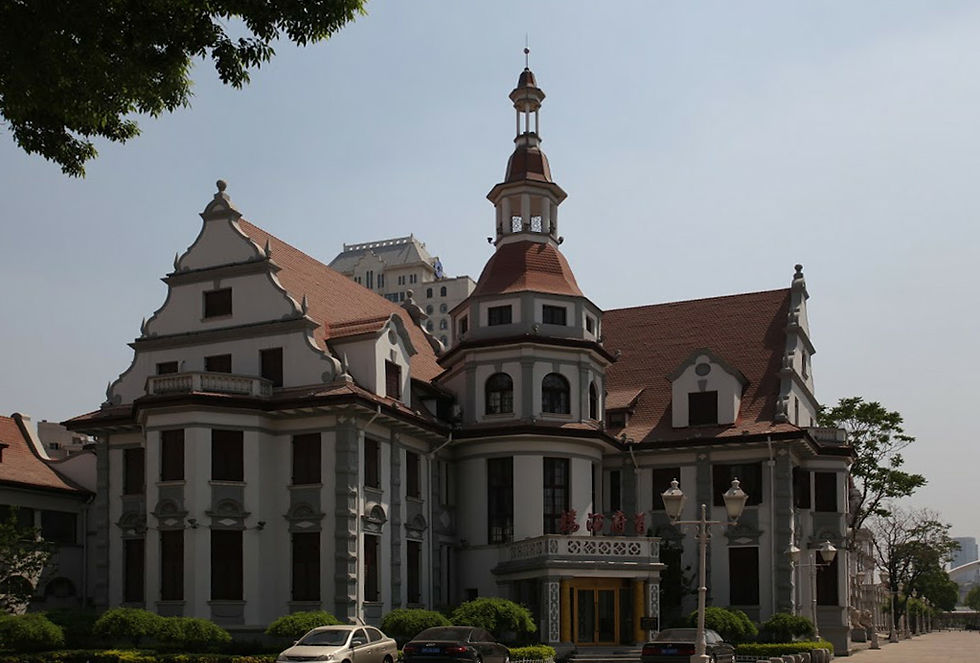
Su Bin took us inside. The building was occupied by many families, one family per room. The only privacy was sheets hung from the ceiling. One family asked us to sit down and the man of the house peeled apples for us to eat. He treated us as honoured guests. Su Bin found the stair to the lantern on top of the tower and we went up to look out over the city.
EVE: The dance I was invited to turned to be a dance variety show. One girl's dance was called "Modes and Kiss". A dance choreography by five young men, called "Climb Mountain", was a cross between disco and kungfu.
September 19
Evening: Nine students came to visit my room.
One was a graduate student and young teacher, He Jian Qing (Jeanette). She often said, enthusiastically, "Sure! Sure!".
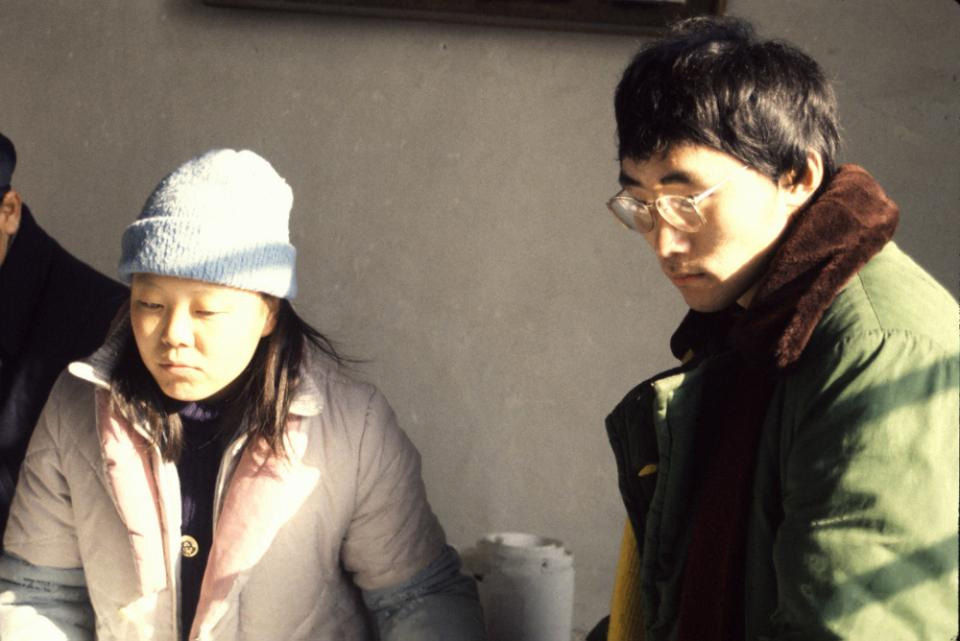
He Jian Qing and Qiu Kang
September 21
A graduate student dropped by to talk about his design for a ten-story mixed-use atrium building at Xi Dan in Beijing. No-one builds this dense in Canada, There was a chance his design would actually get built. China's construction was accelerating and there was a shortage of architects.

My sketch of the Section and Roof Plan of graduate student design
September 22
I looked through more of my books for Xu Subin looking for material related to form and meaning, behaviour and space.
Evening: Three 4th year students came to visit and talk about their work. The conversation was in English.
September 23
Third year design studio. We are working on housing design.
Jeanette suggested we do some experiential exercises. We went outside, broke up into groups and did three experiments:
1. Look at buildings around us on campus (three to six floors high). Approach them until we feel the roof line is not visible. This is the threshold where a building shifts from being an object in the distance to a wall of the space I am in. We measured by pacing. We found this threshold was found roughly when the ratio of distance to height was 1 to 3.
2. Comfortable Conversation distance: Close was from 0.7 to 1.0 meter. Far was 1.7 to 2.0 meters.
3. The distance at which facial expression was still discernible. It was about 25 meters. At a distance greater than this it was difficult to read the expression on someone's face. This dimension is the threshold where the degree of human interaction was gained or lost in plazas or widths of streets, It is the height at which residential building loses connection with people on the ground. It tells you how far the back seat in a theater should be.
September 26
Tianjin has the most extensive, and most intact, Foreign Concession Areas in China. When I had time, I went alone, or with students, on bicycle to explore these architectural “museums”. Qiu Kang, was especially enthusiastic. With Prof. Jin’s permission, we planned what we called “The Quick Research Project”. We want to invite students on a tour of Concession housing, do measured drawings and make a simple book to be shared by all the participants.
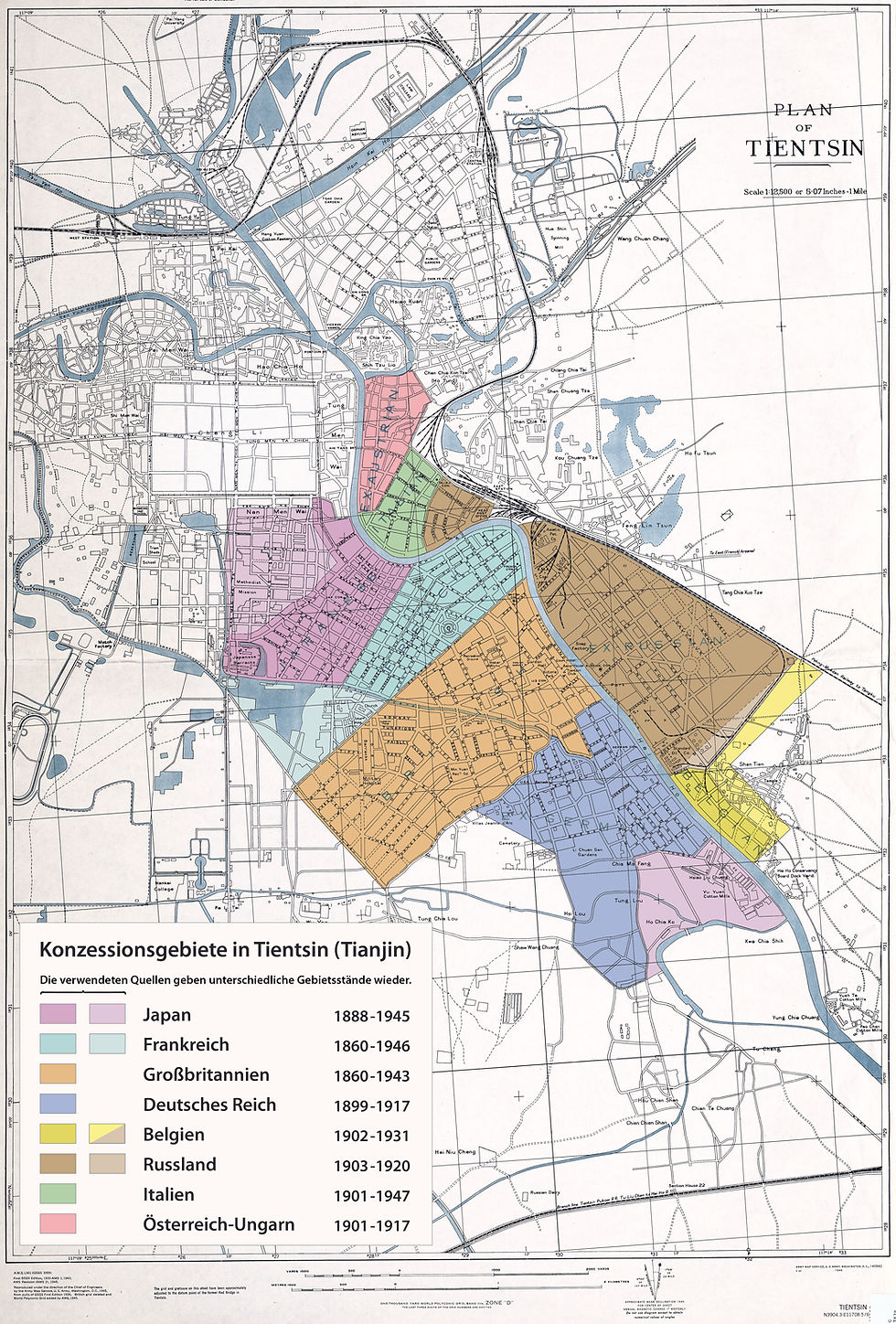
By Maximilian Dörrbecker (Chumwa) - Own work, using this map from 1942 as background. Sources for the concession areas:1902 (?) Map of Tianjin (Chinese version) 1 902 Map of Tianjin (Western version)1912 T'ien-chin - The Settlements Map1941 Peiyang Map1942 British War Office / US Army Map Service Map, CC BY-SA 2.0, https://commons.wikimedia.org/w/index.php?curid=29301826
September 27
Gymnasium design. Some struggling students made a great leap forward.
Sheng Kai visited me to talk about a Model of History with special reference to Architecture.
Attended an evening banquet for the foreign teachers at Tianjin University hosted by the Tianjin office of the Ministry of Education. In China the national ministries, in addition to head offices in Beijing, have provincial and some municipal offices. The vertical axis in the administrative system is very strong.
September 28
Qiu Kang and I planned the route for the bicycle tour of Concession Area architecture. He gave me a copy of a 1931 map of Tianjin showing those Areas. Qiu Kang's design work is very strong. He did a proposal for a tall tower on the axis of the Tianjin University but east of it on Yingkou Dao. If built, it would among the first skyscrapers in Tianjin. I went to his home at the Teacher's College just north of Tianjin University for lunch. His parents were very warm. I could speak some Chinese.
Evening: A 4th year student dropped by to discuss his exploded wheel design for the gymnasium.
September 29
AM: Read about Kurt Lewin's Field theory, a psychological theory (more precisely: Topological and vector psychology) which examines patterns of interaction between the individual and the total field, or environment. The concept was developed by Kurt Lewin, a Gestalt psychologist, in the 1940s.
PM: I explained what I learned to Xu Su Bin. She was very happy with the ideas that came out. Adapting his theory to spatial analysis will not be too difficult.
September 30
AM: Bike tour of Tianjin Concession Areas with Qiu Kang and the 3rd year students. They enjoyed it.
Nothing has happened about finding a machine to play the video tapes I brought from Canada. Zhang Chi was supposed to find one, but I have heard nothing. Impatient, I asked Zhu Jian Fei, with whom it was easy to speak English, to ask Jin Qi Min whether he could find a video tape player.
October 1
National Day
In the morning I parked my bike by Food Street and walked through Culture Street taking pictures. I looped back through the old city. The most interesting and prominent building is the one Xu Su Bin showed me last year, the Guangdong Assembly Hall. It was built in 1907 under the rule of the Guangxi Emperor. Guangdong is a province in southern China. These halls were common. They were 'embassies' where merchants and travelers from out-of-town provinces could meet. Local people were not accustomed yet to 'tourists' like me and stared as I took pictures.
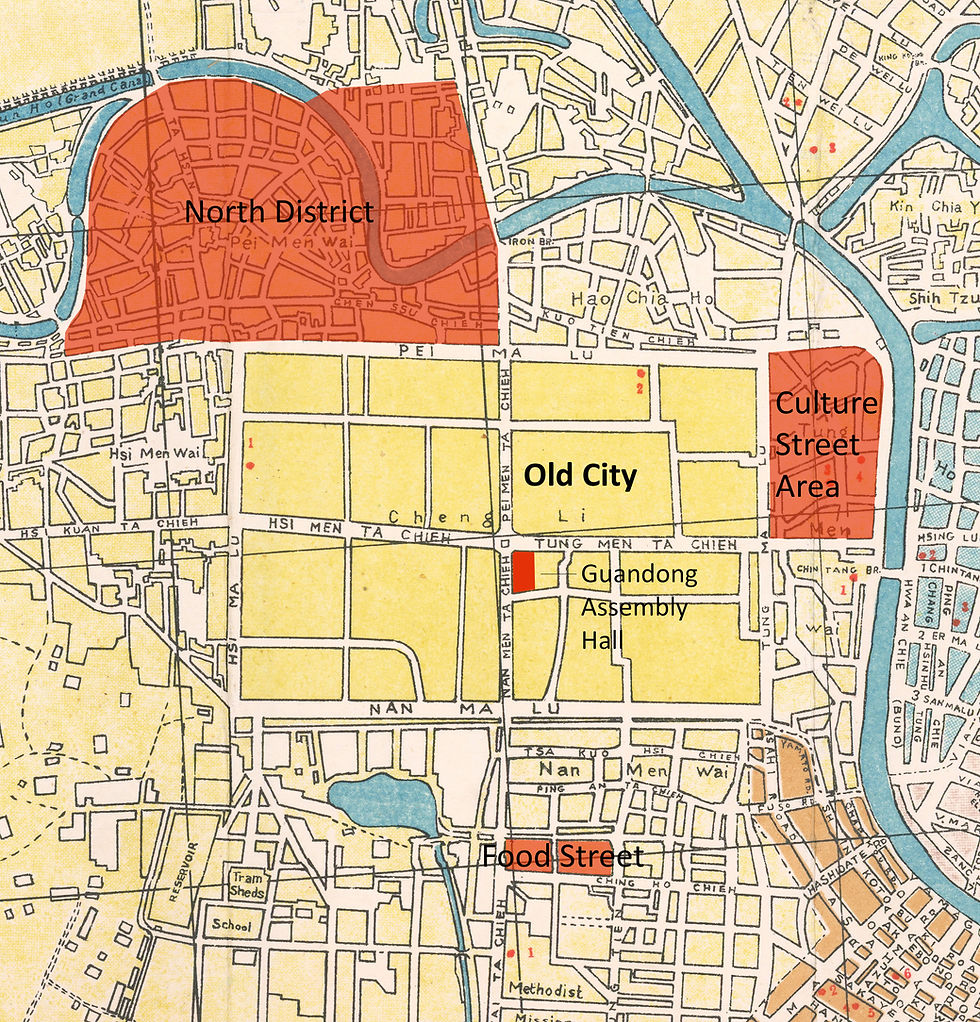
Tianjin 1931
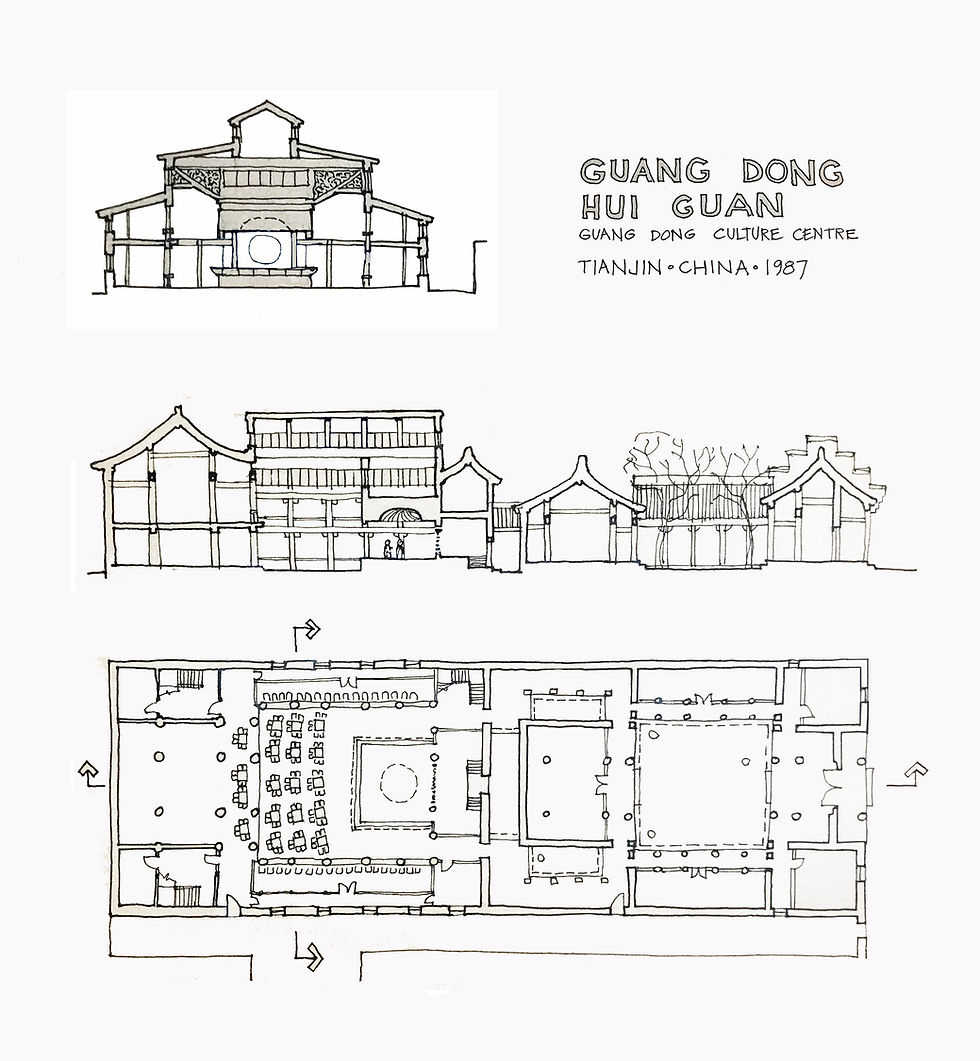
Guangdong Assembly Hall, Sketch made in 1987
The Hall was proposed and built by Tang Shaoyi, a customs official of Tianjin, in 1907.

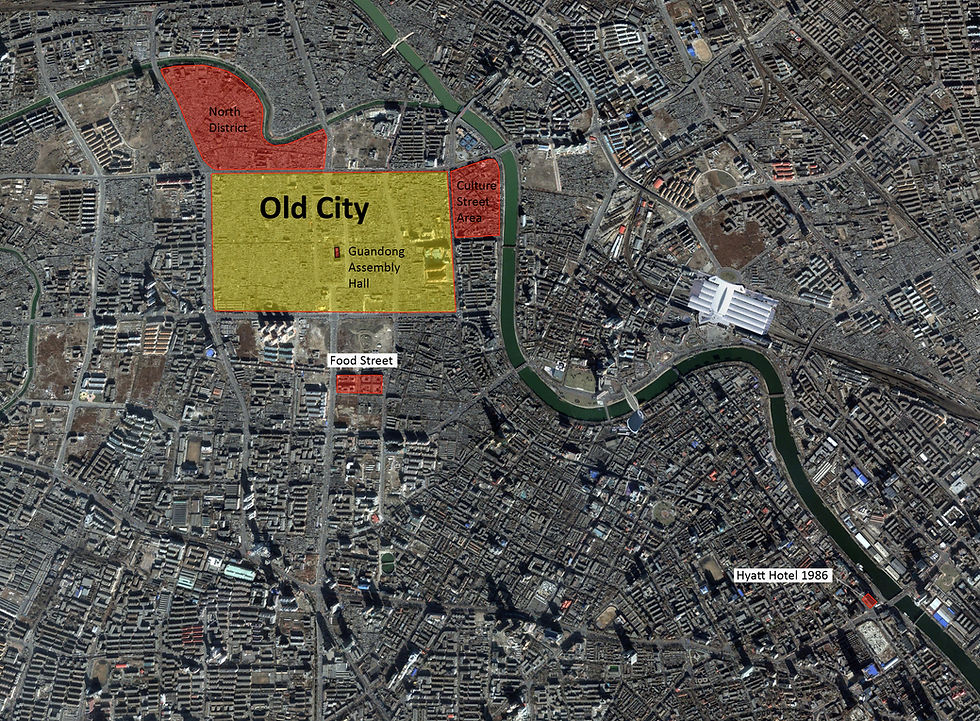
Tianjin 2000
The long shadows of the first few high-rise buildings are visible. The only tall building in the city when I first visited in 1985 was the under-construction Hyatt Regency at 19 floors, the red spot in the bottom right of the image. The Guangdong Assembly Hall was being repaired after the damage caused during the Cultural Revolution. The right half of Food Street was built and open. In 1986 the Culture Street Area used the main diagonal street in the old existing buildings to sell Chinese arts and Crafts.

Old City 2000 and 2004
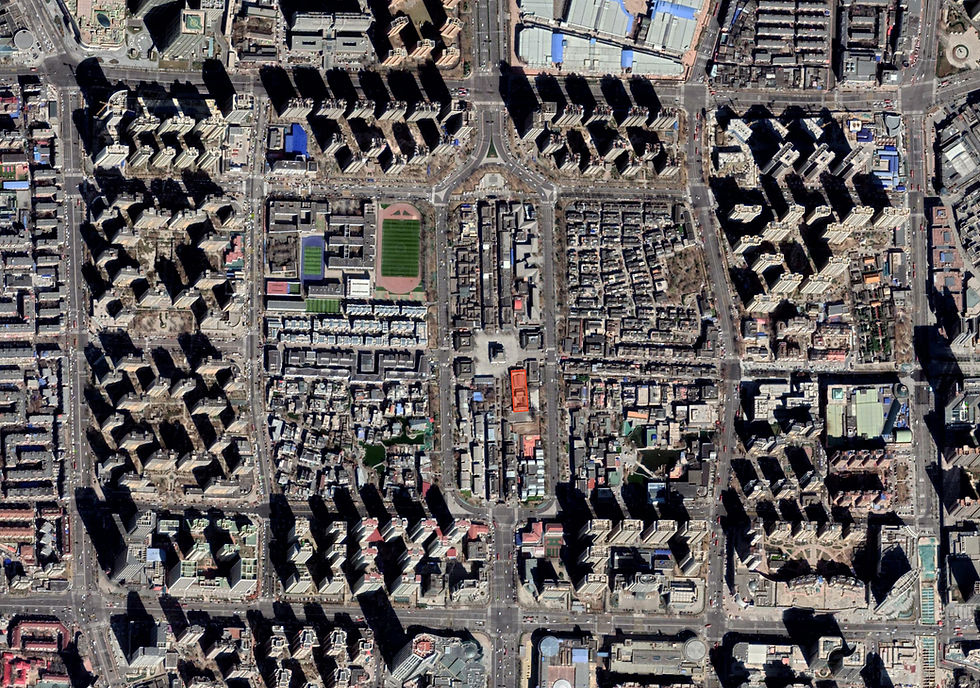
Old City 2020

North District 2000 and 2009

North District 2020
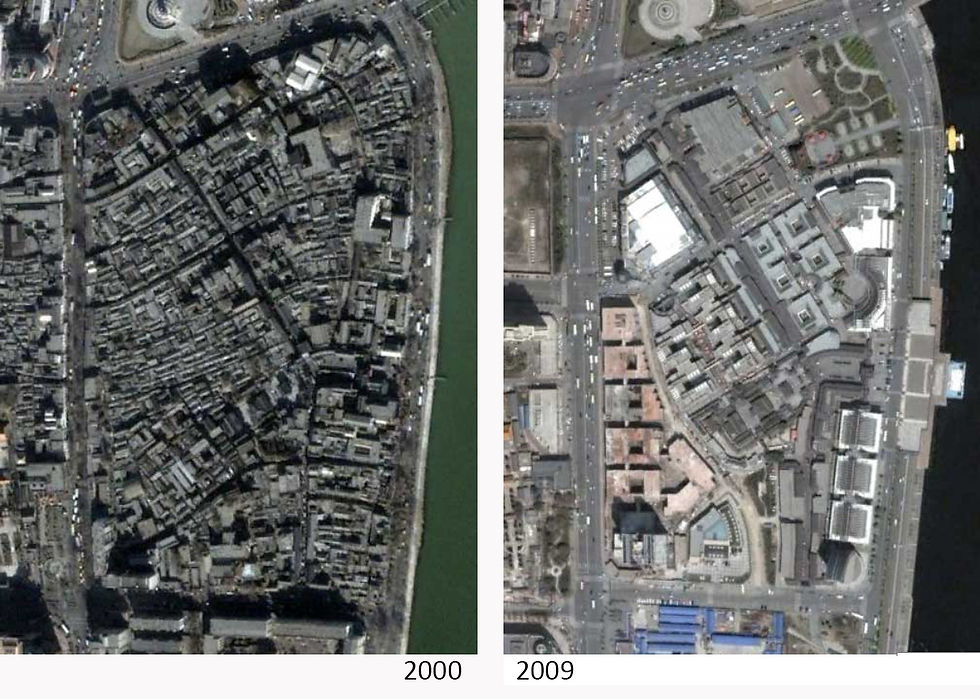
Culture Street Area 2000 and 2009
[Note from 2021: This transformational process occurred all over China over the next 20 or 30 years. Much of the criticism from the West came from those who ignored, or were unaware of, the extremely dilapidated condition of the existing housing; the ownership obfuscation created by migration, displacement, and political turmoil; and the question of the location value of downtown land. Was it fair to maintain such low density housing in areas served by the best physical and social infrastructure? If it remained low density and land was allowed to have market value, only the very rich could afford to live there. However regrettable the loss of heritage, China was facing a very complex practical problem. ]
October 1
Evening
Qiu Kang invited me to join his family for supper to eat jiaozi (dumplings). I had been there once before. I had had no trouble finding the street but did have trouble identifying his building. So many of the housing for the staff and students buildings looked alike; row upon row of six story blocks. I remembered it was on the second floor, the middle door, but which building?
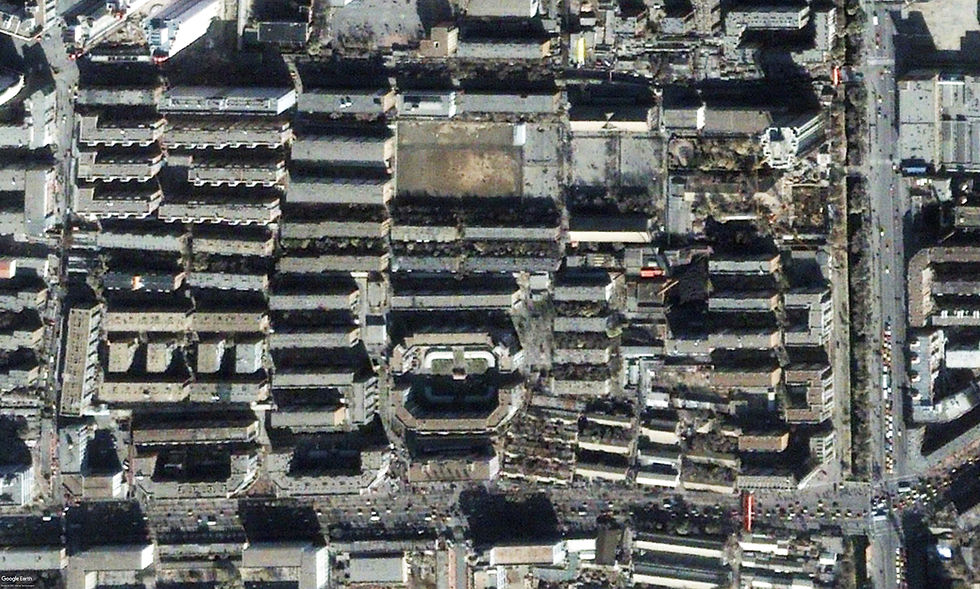
Tianjin Normal Teacher College just south of the Old City
I relied on intuition and found it. Before I arrived, Qiu Kang was worried I would not find his home and went out to look for me. We didn't meet each other and he arrived a half hour later surprised I had made it. I spent the time with his father looking at Jin Qi Min's book, "A Hundred Chinese Patterns". It was based on Christopher Alexander's "Pattern Language" and filled with Jin Qi Min's brilliant sketches. We spoke only a few words in each other's language. He teaches Probability Theory at the teacher's college. Qiu Kang's mother teaches Ancient Chinese language and literature at another teacher's college.
Qiu Kang's younger brother, Qiu Jiang and his girlfriend were also there. They are both architectural students at Qinghua University in Beijing. His English was perfect. He plays the violin. He told me the Head of the department of architecture was Chairperson of the women's architecture group. Her name is Gao Yi Lan.
October 2
Wrote a letter to Pieter Sijpkes about Qiu Kang's application to study at McGill School of Architecture.
I bought foreign orange juice at the Friendship Store with my Foreign Exchange Certificates.
Qiu Kang dropped in asking for help with his application to McGill University.
Zhu Jian Fei dropped in to say, "Don't worry about Zhang Chi and your video tape machine. He will arrange it." Zhu Jian Fei and I talked about civilizations and world history. I sketched two diagrams about the emergence of a global civilization and about the life-cycle of a civilization.

Global Civilization Process: Rivers flowing to one sea, on the left

The predominantly linear axes of spiritual architecture point like spokes
to a new collective center
I thought more about the rivers of civilization sketch and made a radial time chart of history with the future in the middle and the past at the outer edge. I slowly worked on this idea for several years. Around 2005 it took the form shown below.

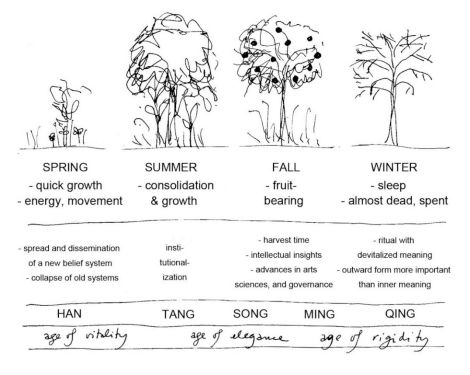
Life Cycle of a Civilization
The concept of the life-cycle of a civilization was reinforced when I discovered Liang Si Cheng’s (1901 - 1972) description of the sequential “vigour, elegance, and rigidity” stages of Chinese civilization. These characteristics of the growth cycle of a civilization could also be applied to a tree with its period of youth and vitality, period of fruition, and period of decline. Liang Si Cheng was referring to the vigor of the Han, the elegance of Tang, Song and the rigidity of Ming, Qing. From his field research of sites all over China he found this pattern in China’s evolution. I think he found a universal pattern. He was a Chinese architect and scholar, often known as the father of modern Chinese architecture. His father, Liang Qichao, was one of the most prominent Chinese scholars of the early 20th century.
The sun that provides the heat and light upon which the system depends - what is the counterpart for a civilization? A Vision of Perfection? Where does that come from?
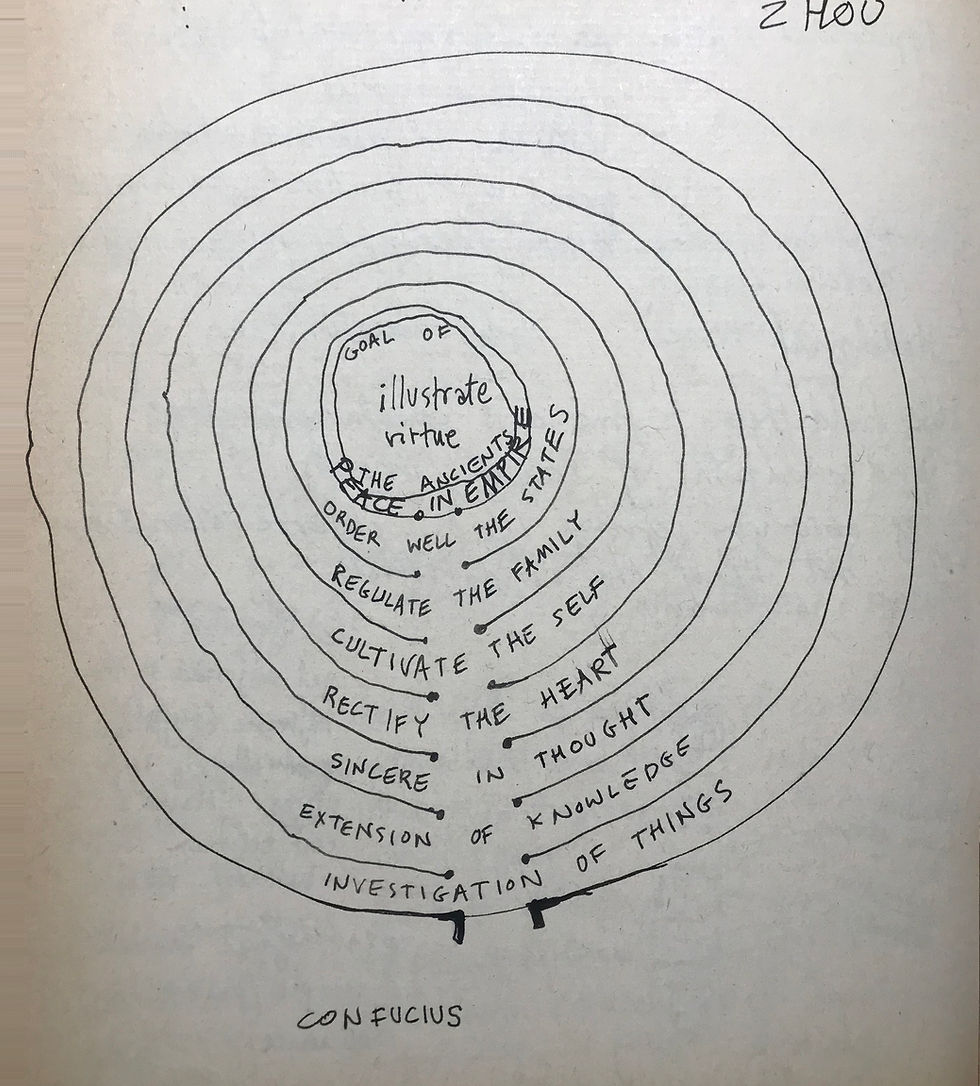
My diagram of the Confucian classic called The Great Learning quoted in part below:
The Great Learning shows the inter-relationship of the individual, society and administration, and between inner an outer civilization.
"What the great learning teaches, is to illustrate illustrious virtue; to renovate the people; and to rest in the highest excellence.
The ancients who wished to illustrate illustrious virtue throughout the kingdom, first ordered well their own states. Wishing to order well their states, they first regulated their families. Wishing to regulate their families, they first cultivated their persons. Wishing to cultivate their persons, they first rectified their hearts. Wishing to rectify their hearts, they first sought to be sincere in their thoughts. Wishing to be sincere in their thoughts, they first extended to the utmost their knowledge. Such extension of knowledge lay in the investigation of things.
Things being investigated, knowledge became complete. Their knowledge being complete, their thoughts were sincere. Their thoughts being sincere, their hearts were then rectified. Their hearts being rectified, their persons were cultivated. Their persons being cultivated, their families were regulated. Their families being regulated, their states were rightly governed. Their states being rightly governed, the whole kingdom was made tranquil and happy.
From the Son of Heaven down to the mass of the people, all must consider the cultivation of the person the root of everything besides."
* * *
I learned about an altar at a Temple inside the Forbidden City called Five Colours Earth. This was one of the sites where the Emperor would pray and perform rituals for the success of the annual harvest.
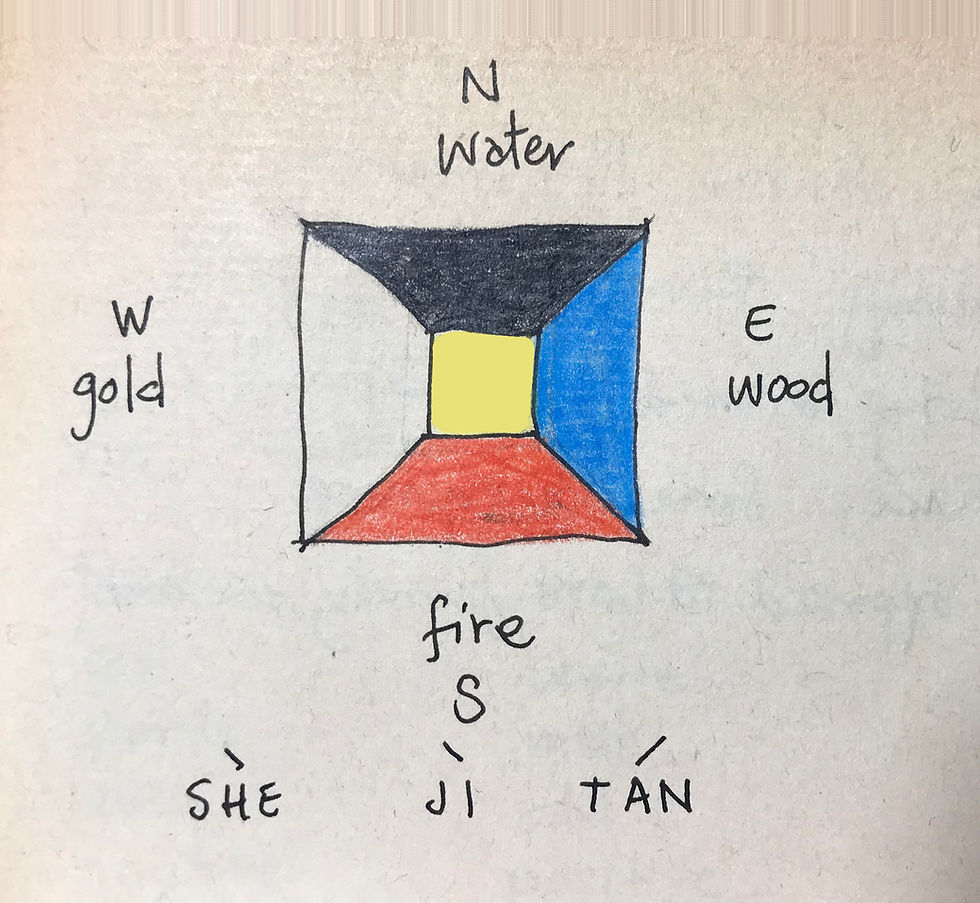
October 3
Help third year with their designs. On their drawings they wrote names of spaces in English. One design had a 'social intercourse space'. Technically it was right but I suggested taking out the word 'intercourse'.
I sent a letter to the Beijing Women Architects Group proposing I visit them sometime between November 10-13.
In the evening I went to buy cookies and local snacks at the little shopping street on the campus. I often came here ans enjoyed the atmosphere. Everyone brought their own shopping bag; there were no throw-away plastic bags. I watched in amazement as a skillful women tied string around the necks of six big beer bottles then wove it into a handle that allowed the customer to easily carry them home. While I was there a man came running out of the restaurant upstairs with five others chasing him. Out on the street they caught up to him and each gave him a savage hit or kick and ran off. Soon more men ran out to chase the attackers. It made me feel quite sick and helpless. Several women came from the store to look after the victim who was lying unconscious on the road. I felt bad that I could do nothing. So I eventually left.
October 4
I saw Jin Qi Min in the design studio. He seemed aloof. Did approaching him about getting my videos played bother him? I don't know. Speculating is no use. The combination of this unease about my tapes and what I saw last night at the restaurant made my spirit droop. I went for a ride and walk downtown. I found some apricots. I bought one pound because I didn't know how to say a half pound.
October 5
Margaret returned my book, "Toward a New Psychology of Women". Sheng Kai dropped in to return my notebooks. I prepared for a lecture about housing in Canada and St. John's. Qiu Kang came by asking for help with applications to western universities. We went to a downtown library to look at Peterson's catalog of North American universities. We found about a dozen good schools of architecture to apply to. He said during the Cultural Revolution, only soldiers and peasants went to university. And they were nominated.
October 6
Read "Toward a New Psychology of Women", again. Review third-year housing designs.
Fourth year students drop in in the evening. The exploding wheel design student dropped in. He is a hard worker. Qiu Kang came by; wanted help with a letter to Tony Vacchione.
October 7
Gave lecture about housing in Canada.
I'm feeling closer to the students.
Zhang Chi (Carry) came back from Beijing. He wanted help writing a letter to the Australian Embassy saying that after October 1, the Chinese government was reducing the number of Chinese students studying abroad. They must have work experience before they go away to study.
In the late afternoon I joined a Chinese class for Foreign Teachers. The Chinese teacher, Chen Laoshi (Teacher Chen), was very friendly and skillful.

Chen Laoshi
Teacher Chen, taught us two evenings per week. She had an amazing ability to address what you don’t know. Answers to your questions always popped up just before you voice them.
With her I had my first entree into the Chinese language ocean. The scene in the textbook was a student knocking on his teacher’s door. The student knocks and says, “Zhou Laoshi, zai bu zai?”; literally, “Zhou [a surname] Teacher, at not at?” A voice from inside the door says, “Zhou Laoshi, bu zai”; literally, “Zhou Teacher, not at.” The literal English sounds choppy and telegraphic, but it is not difficult to feel the meaning.
Chinese people are amused when they hear Chinese translated literally into English. A good example is Chairman Mao’s famous words of encouragement for young students. He said, “Study well and every day you will advance”. In the Chinese ‘telegraph’ style that looks for memorable repetition and symmetry, his words were “Hao hao xue xi; tian tian shang!”. In literal English it says, “Good good study; day day up!”.
The World’s Most Efficient Languages
How much do you really need to say to put a sentence together? The following is an excerpt from an article in the Atlantic by John McWhorter:
"It’s surprising what a language can do without. In Mandarin Chinese, a way of saying “The father said ‘Come here!’” is “Fùqīn shuō ‘Guò lái zhè lǐ!’” Just as in English, there is no marker for the father’s gender, nor does the form of the word shuō for “said” indicate whether the speaker is me, you, or him. The word for “here,” zhè lǐ, can mean either “right here” or “to here,” just like in English. But Mandarin is even more telegraphic. There is no definite article like “the.” The word for “said” lacks not only a suffix for person, but is also not marked for tense; it just means “say.” It is assumed that context will indicate that this event happened in the past. Much of learning Mandarin involves getting a sense of how much one can not say in an acceptable sentence. Moreover, anyone who has sampled Chinese, or Persian, or Finnish, knows that a language can get along just fine with the same word for “he” and “she.”
https://getpocket.com/explore/item/the-world-s-most-efficient-languages?utm_source=pocket-newtab
When I studied French in Canada, I could hang on to familiar word and thought relationships; but with Chinese, you had to switch to new conceptual tracks. Words trace the shape of the world. Projecting English and Chinese onto the world made it more three-dimensional, like hearing in stereo instead of mono.
There are some areas where languages do not overlap. I asked a student once, “You didn’t do your homework, did you? She said, “Yes”, meaning “Yes, I didn’t do it”. My reply to her “Yes” was, “But, you didn’t do it!” Immersing yourself in a new language world is a bit like having one of those illnesses where your mind is fine but your mouth and ears are paralyzed or dysfunctional. Everything you say is understood by no-one; and everything you hear is incomprehensible. You are isolated, and loneliness mounts.
Understanding colloquial aspects of a language requires knowledge of its background culture. For example, “He really hit that one out of the park”, as praise for doing something well, makes no sense unless you are familiar with baseball. Adapting to China eroded my use of colloquial English. Later my classmate, David Covo, said, hearing me speak, “Joe, your English has a Beijing accent”.
October 11
I find social encounter requires more effort than I'm used to. None of it as at the speed and depth I am accustomed to in an English world. Lacking language skills and knowledge of the culture I am a child again.
A visit by Professor Zhang Wen Zong really cheered me up. He wanted to 'talk freely'.
He told me there were some policy changes at the university. The Iron Rice Bowl was being weakened. Professors could lose their jobs if they don't perform. And students were allowed to change departments.
He invited me to comment on a railway station idea he had.
I lent him an article about the impact of Chinese Gardens on European landscape design.
He will help me with the Zhang Chi videotape situation.
He thinks I should stay in China for a long time. He said the world will have a global culture. "All high spirit comes to the same place".
October 12
There was a youth peace gathering by the river in the Italian Concession. A large plaza was under construction (now called Wanda Plaza). We joined a group of youth making a one-hundred meter long painting. Some of the best painters in the city were there. It will be sent to the United Nations in New York.
Back in my room I read China's English language newspaper, the China Daily. The headline was the arrival of the TV show "Disneyland" in China. Further down the page was a report on the arrival of Queen Elizabeth II. She was here for a few days with Prince Philip for a state visit. Mickey Mouse had eclipsed the queen.
Queen Elizabeth II was the first British monarch to visit China. One of the most important tours she had ever undertaken, it was seen as a critical piece of diplomacy, coming about two years after the two countries agreed on the future of the British Crown Colony of Hong Kong, and during a time of increasing British-Chinese trade. In 1982, Prime Minister Margaret Thatcher paid a state visit.
October 13-14
I prepared for Architectural English Class. Looked in the library for information about Alvar Aalto. Can't find anything.
My bicycle pedal was stolen.
Fourth year gymnasium designs are coming along quite well. English class, okay. A foreign teacher told me Chinese people have no body odour because they have few dairy products in their diet.
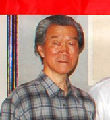
Zhang Chi
Zhang Chi came to visit. A warm hello, no estrangement. Did I imagine it all? Did Zhang Wen Zong straighten it out? I'll never know. Zhang Wen Zong did say sometimes Zhang Chi's memory lapses. His wife was killed two years ago by a train. He has since remarried. I still don't know what's happening with my videos.
October 16
I heard a story of a westerner who took his coat to the dry-cleaners here in Tianjin. The man behind the counter whipped out some scissors, cut off all the buttons and handed them to the westerner. The dry-leaning machine does not like buttons. It only costs a few cents to sew them back on again.
I pedaled with one pedal to buy a new pedal at the International Market. Got a haircut at the Friendship Hotel.
October 17
Third year students have worked hard for two days, some have been up all night. I worked with one person all morning. The fourth year students have begun their watercolor presentations for their gymnasiums. All hand-drawn, no computers. The final presentation is done with ink and water colour wash on a large sheet of water colour paper stretched on their drawing boards. Their skill with water colour is impressive.
October 20
At five o'clock in the morning I woke up the doorman, Wu Shifu, to let me out of the guesthouse. He unlocked the folding metal gate that stretched across the entrance. In the dark I rode my bicycle to the front gate of the university, parked it and walked across the street to the number eight bus stop. Three people cycled by. One of them occupied the street singing a Beijing opera loudly in the pre-dawn darkness. I took it as a good omen. People at the front desk had bought my Beijing train ticket for me. I went through the foreigners' entrance of the train station. Two hour train ride to the Beijing station where I bought my ticket back to Tianjin. It cost 5.50 yuan. I walk to the Beijing hotel and had a 12 yuan Western American Breakfast.
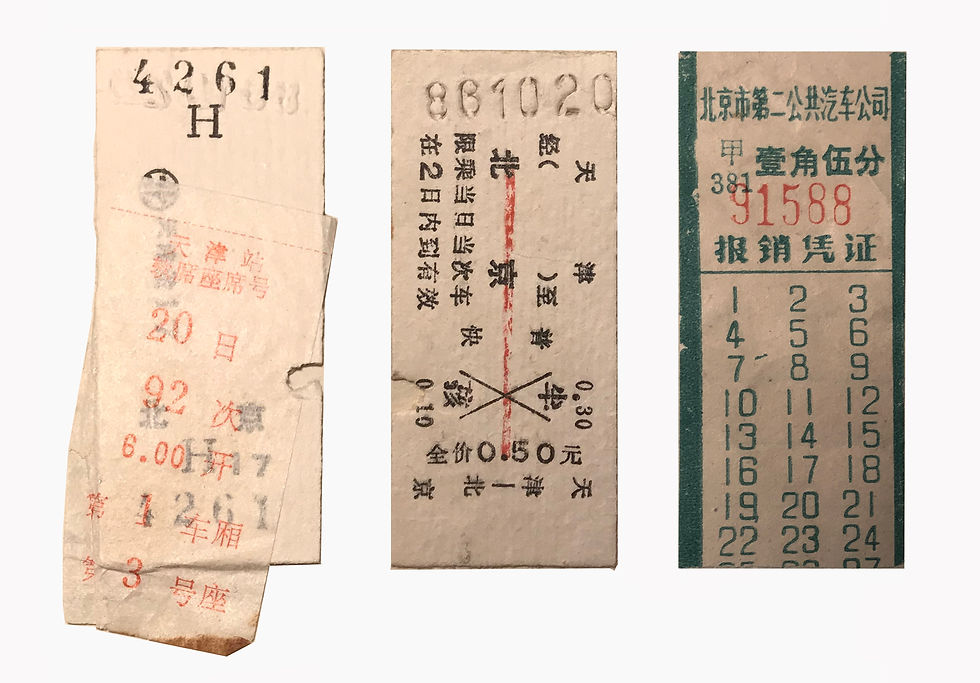
Souvenirs of my first 'solo' trip to Beijing. In the middle is the ticket to Beijing dated 86-10-20.
On the left is the ticket back to Tianjin on the same day at 6:00pm. On the right is my 15 cent Beijing bus ticket for route 381 that took me around the Third Ring Road. I wanted to feel the scale of the city.
I took buses to the Canadian Embassy at the corner of Sanlitun Lu and Dongzhimen Wai. There I met Scott Wade and George Lowe, construction managers. Later I visited the site office of the new Canadian Embassy under construction a bit further to the west. I saw a large excavation with a raft foundation on heavy clay at the bottom. Site area: 0.7 hectares. Toronto architects. Chinese construction company. Mr. Lowe does not have the authority to stop the work if anything goes wrong. He's staying for two years living at the Lidu Hotel on that narrow road to the airport. He has the use of a car. There are probably no private cars in China; cars and their drivers belong to work units. He dropped me off near the current embassy. Someone helped me find out about an All China Women's Federation exhibition of educational toys. I was curious. It was on the West Third Ring Road. It was an excuse to look around. The exhibition was not so much educational toys as visual aids for teaching science and math. I was the only foreigner there. Ninety percent of the people were young women teachers, many taking notes. Lots of homemade skills in the displays. Lots of color. Many puppets. There was a kit for building houses for children. No toys; I was a bit disappointed.
I took buses back to Wangfujing, a major shopping street with the Beijing Hotel at the south and the National Gallery of China at the north. I bought some drafting supplies. I bought some books at the foreign language bookstore. I couldn't find anything by Zhang Xin Xin ( 张辛欣 born 1953), a Chinese writer and director. I read a book called Chinese Lives (1986) that she co-authored with the journalist and oral historian Sang Ye.
There were a few foreigners on the street. One was wearing a Walkman. [Note from 2021: The original Walkman was released in 1979 and by 2010, when production stopped, Sony had built about 200 million cassette-based Walkmans.]
At the bus stop a woman's little daughter wandered away. She picked up some stones. The mother called, harshly I thought, and the little girl came over, and the mother hit her fairly hard. On the bus, one of the ticket collectors, usually women, saw me looking at my map. She called me with her eyes. I showed her my map and said “Train Station” (Huo Che Zhan = Fire Vehicule Station) in Chinese. She pointed out the stop where I should get off. I took the train back to Tianjin, and the No. 8 bus back to the University. Mission accomplished. I made it to Beijing and back on my own!
October 21
Xu Su Bin came for a visit.
She lives in a women’s dormitory and shares a room with Sun Li Ping and one other girl. By their standards, it is not crowded. Showers are in a public bath in another building. They live on the north side of the building. She said only the north side of the building gets heat in winter. Her advisor is Peng Yi Gang, a well-known architect in China. She is a little afraid of him. He hesitates to speak with foreigners. She wants to study the psychology of architecture in three parts: Ancient Chinese, Modern Chinese, and Western.
October 22
I met with the other fourth year teachers to discuss and grade the results of the quick design project. Later we talked about the history of North America, materialism, aspirations, and the global village. They said they hoped I would stay longer, at least another term.
PM Another meeting in the afternoon to grade the work of the third year students. We put them into piles; average, second, high. No failures. Later I helped Qiu Kang with an application to a university in Buffalo. Zhu Jian Fei dropped by to tell me he was one of 150 students from China who will visit England. They will have a final English examination in Beijing on November 15. This activity was one of the results of the queen's recent October 12-18 visit to China.
October 23 Architectural English Class. I gave a lecture about beauty: Beauty has structure and the beauty of structure. I used examples from Nervi, Maillart, Bach, Gaudi, Islamic and Gothic architecture. For the second half of the class, I divided the 80 or so students into ten groups. Each group translated a brief quote related to architecture into Chinese. When they were done they gave the Chinese translation to another group to translate back into English. The group that did the first translation compared the translated English to the original text. The class was very animated.
Sheng Kai dropped in. I helped him with an application to a university in America. I started to feel sad. What if everyone leaves?
October 24
A foreign teacher told a story she heard about some western doctors working in Tianjin. The patient was having trouble breathing. The western doctor gave the patient a catheter for his heart. The Chinese doctors removed it. They were afraid if the patient died using a western technique, they would be assaulted by the patient's relatives. Doctors make about one hundred and twenty yuan per month. Nurses make about fifty.
October 25
Zhang Chi (Cary) said he was married last week. He gave me some Xi Tang (happy candy) and invited me to his home to meet his sister, parents, and his wife Emily. I asked him about the video tapes. He said they have to be copied into a different format. Mine are in NTSC; China uses PAL.
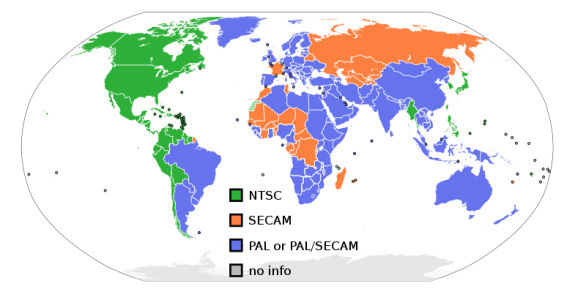
The AV Center is waiting for a shipment of new tape. Maybe wait a half month. I wish someone had told me before.
PM
I went with Qiu Kang to the Tianjin Yang Liu Qing Art Society. I bought chops for everybody in Canada as Christmas presents and a bowl for Mom and Dad. On the way, Qiu Kang said, “Let's speak Chinese.” I struggled. I liked it. At supper Andrea and Nick, two foreign teachers said their friend Harry from Qi Qi Har wants to get together with me.
October 27
I prepared materials for a lecture about housing for the Architectural English class. In the afternoon I visited the fourth year studio.
Evening: a third year teacher walked in to my room and said a lecture was in progress in the Third Year Studio. I should come and talk to them about their recent "quick designs" for a park. I used the idea of Yin Yang, Contrast and Harmony: light-dark, cool-warm, male-female, positive-negative, Heaven-Earth, sky-ground, sun-shade, motion-stillness, separation-union, order-disorder, far away-close, round-square, soft-hard, noisy-quiet, open-closed, high-low...
October 28
AM In the Third Year studio. No feedback about last night's spontaneous lecture.
PM Afternoon Chinese class. It's getting easier to understand. Chen Laoshi is wonderful. She's going to the US to see her father who was a member of the Guo Ming Dang. He went to the states in 1949. Her mother was a communist and stayed in China. She was sent to Inner Mongolia for ten years because of her impure connection with the Guo Ming Dang.
October 29
One of my fourth Year students said he lost the perspective of his gymnasium that showed it at night. I had encouraged him; I thought it was very good. Some other members of the group told me it was not lost. It was criticized by another teacher, so now it's "lost".
At lunch Nick, an English teacher from Texas, told me the story of failing someone last year. The head of the department came to Nick's place and asked him to write another test. The student failed again. Nick wrote two more tests and the student still failed. Nick had to keep writing tests until the student passed.
P.M. The Bauhaus lecture went well. I received a wonderful letter from Gao Yi Lan in Beijing. The architecture women's group invited me to meet with them in November.
Evening
Cui Hong Lin dropped by. He is a graduate student helping with the third year residential project while Jin Qi Min was away in France. He said he enjoyed my talk about contrast the other night. He thought a lecture like that should be given before the design project begins. He said his thesis is about the old architecture concession architecture of Tianjin. He had not hear about my proposed measured drawing activity with Qiu Kang and some students. A hole in the network?
October 30
Xu Su Bin was visiting. The good conversation ended when she said she had to leave for dinner. The dining hall opened at five thirty. By six o'clock all the best food is gone.
October 31
Heat in the Foreign Experts Building is turned on.
The third year students have a deadline of November 9.
I photocopied 3 sets of chapter one of "Towards a New Psychology of Women" and sent them to Gao Yi Lan at Qinghua University. They are for her and two of her colleagues, members of the architect's women's group in Beijing.
Third year students have started to put their ideas onto large sheets of watercolor paper.
November 1
I met with the teachers for one hour before the students came at nine o'clock. One of them said he had to get plastic cups in his house. Every time he has a quarrel with his wife, he breaks glasses.
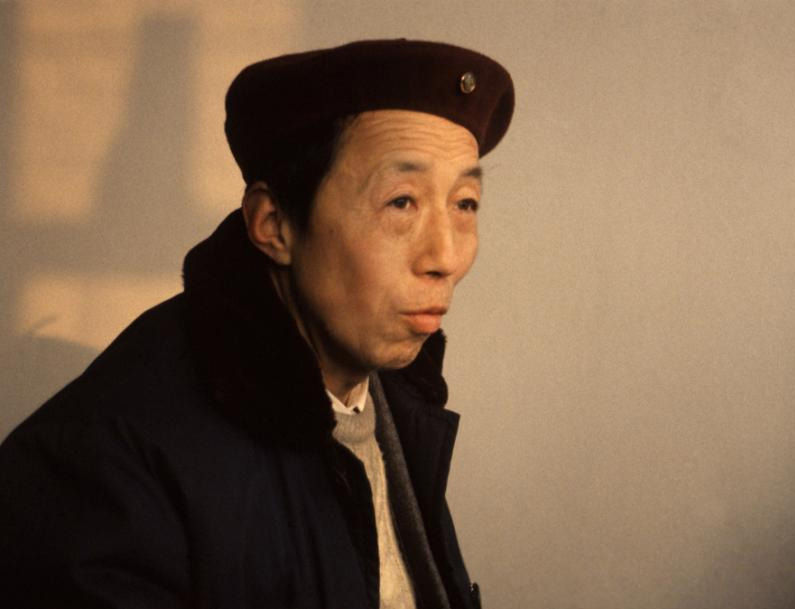
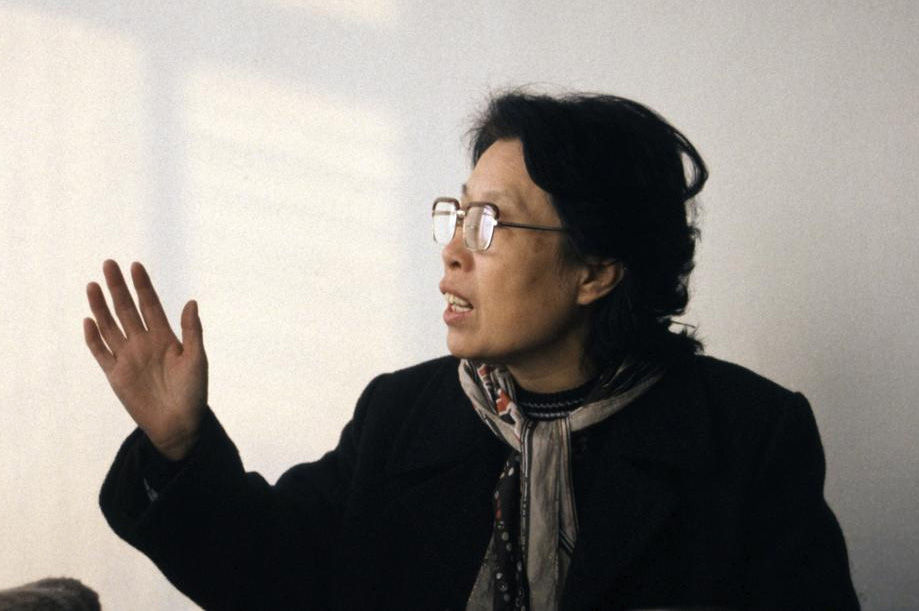

Zhang Chi (Carry) at left
The fourth year students have nearly finished their gymnasium designs. The group with the best idea has the weakest presentation. Sun Yi Lu, a fourth year student, asked me if I believed in God. Her boyfriend is a Christian. His parents want him to marry a Christian. She goes to a small church with him, but doesn't believe in God. She said her boyfriend saw me last year at the hospital. I was in the men's bathroom trying to generate a stool sample; squatting with my belt in the crotch of my knee until my legs went to sleep. Her parents like him. She has only been to his home once. I suggested she try to become good friends with his parents. Marriage will connect two families. I told her I believed in God.
I worked on my application to CIDA for a research grant about housing and China.
I asked Prof. Jin whether he could find a structural engineer to come and look at the students’ gymnasium designs and help us. He agreed and told me the engineer would come and meet my group on the evening of November 6 in the studio at 8:00 pm.
November 2
I wrote a letter to the Wai Ban (Foreign Affairs Office at Tianjin University) about continuing my contract for the next term.
Cathy Ferry, my ex-wife agreed to reduce the asking price of our home in St. John's, Newfoundland.
November 3
I met with fourth year teachers to choose designs for a gymnasium design competition. One of my students work was one of three chosen. It was the design by Hua Guang and his group.
November 4
I was in the library preparing for a lecture about post-modern design. I was looking for Ventura's book about complexity and contradiction. Cui Hong Lin said it was there, but I couldn't find it. Cui Hong Lin suddenly appeared and showed me where it was.
I delivered a letter to Jin Qi Min indicating a strong interest in continuing next term.
Evening
The designs chosen for the gymnasium competition have to be redrawn. It will take about one week. There are ninety students altogether. The three gymnasium projects will need about thirty of those students. The other sixty will work on a one week quick design of a gate for the gymnasium. Huo Gang said the concepts for the other two designs cam from their professor. I'm glad my group's idea is by a student. The members of our group are: Huo Gang, Yan Zhuo Jun, Liu Yun Yue, Xiao Nan (five boys) and Zhang Jin Yi, Chao Dan Ting, Li Hong, Wang Yue, and Sun Yi Lu (five girls).
November 5
Afternoon
The Tianjin municipal government foreign affairs office arranged a visit by the foreigners in Tianjin to the site of the new seventy one kilometers long Outer Ring Road. The population was about 6 million [About 14 million in 2021]. We were bused out to the site in the countryside Decide. There was a lot of mud, reporters, video cameras for TV, and multicolored flags. A few speeches were made with a lot of statistics. Then a performance with a half-hour of singing and music. Instruments shrill and piercing.
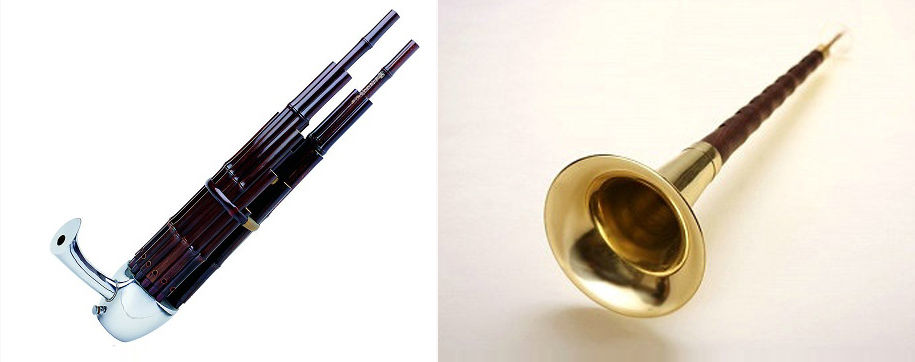
Sheng (left) and Suona (right)
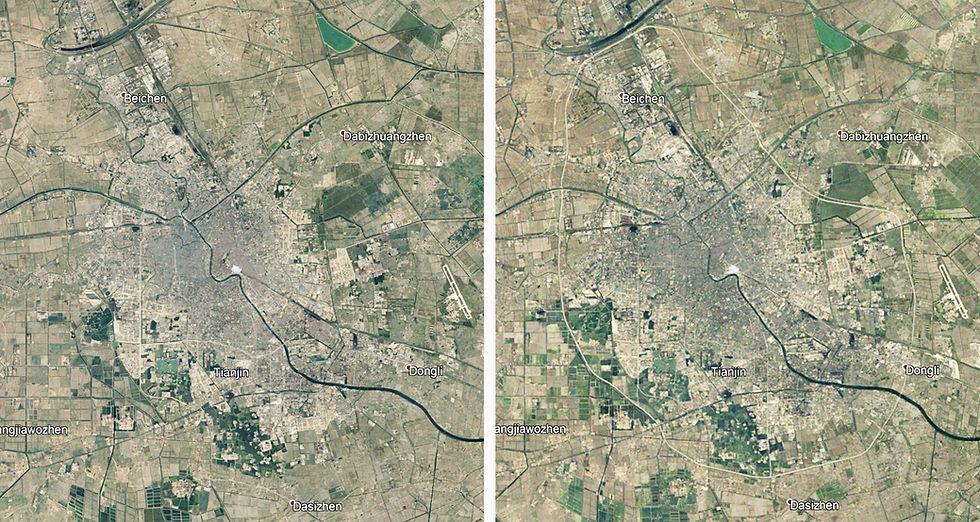
Tianjin: 1986 on the left, 1987 on the right
Evening
The gymnasium team doesn't seem very well coordinated. Some of the details that are emerging don't reinforce the core ideas. Overall, however, the design is crystallizing.
At ten in the evening I phoned Pierre Deschenes in Beijing. He is a Montreal architect who studied at Qinghua University 1981-85.

Pierre Deschenes
I had to place the call through the reception desk downstairs. They talked to an operator who then connected Pierre to the phone in my room. We agreed to meet at the Beijing Hotel at 9:00 am November 10.
November 6
Prepare for a visit with Gao Yi Lan.
I went with Zhu Jian Fei to look at an example of low-rise high-density housing designed by Hu De Jun, and architect Professor at the School of Architecture.

Dinner at students home. Zhu Jian Fei at rear right.
Evening
Professor Liu was coming to look at the fourth year students gymnasium designs. Before eight we were all there waiting. I went out into the corridor to see whether our guest was coming. An older man in a blue Mao jacket and baggy blue pants was walking slowly down the dimly lit corridor. He looked no different from the janitors who swept the halls. “Are you Zhang Laoshi (Professor Zhang)?”, I asked. “Yes”, he said. I welcomed him in and he looked at the students work in a kind and unassuming way. He showed them how to make their designs more “real”, and how to take advantage of the large cantilevers that were possible in space frame design. He showed us how to draw a cantilevered space frame; its depth, bay size, and column spacing.

When he left, we were relieved that our basic thinking was alright. The students were very excited by how much they had learned. They told me Liu Xi Liang was Tianjin’s most famous structural engineer. He had written a book about space frames. He is also the director of a large company that makes lots of money. His work spans the academic and business worlds.
I really appreciated this support from the Department of Architecture.
November 7
I tried to help the students see more clearly the relationship between the section of a building and the elevations. They have a tendency to draw the plan first then the elevations, then a section. A good section will generate good elevations. There's not so much for me to do now because the students are preparing their final presentations on watercolor paper. They make beautiful drawings.
Afternoon
I spoke with Jin Qi Min about the cost of my Canada-China airline ticket. I have already paid for it. It would be more cost effective if I stay another term. He and Professor Yu are negotiating with the Foreign Affairs Office about prolonging my stay. The Foreign Affairs Office has problem. If they help the Architecture Department have a foreign teacher, then they should help all the departments have one. Currently, there they have a budget only for. Foreign Language teachers; not department-specific teachers. Jin Qi Min will make a special appeal to the President of the university when the President gets back from Japan.
Professor Jin said when he was in France he was searched when he went into a department store. A series of bombs had been set of in Paris. The killers wanted France to release three prisoners, including accused terrorist Georges Ibrahim Abdallah, awaiting trial in the killing of a U.S military attache and an Israeli diplomat.
I visited Carry. He was finishing a model for the new Tianjin railway station. Graduate students and young teachers are involved in real projects.

Tianjin New Railway Station
There is a dance tomorrow night for foreigners only. The students are from North America, Europe, Japan, Korea, and many from Africa. Xu Su Bin came by to help me mail my Christmas gifts to Canada at the post office. She said if she becomes a teacher, she will listen to the students' idea not just give her idea.
November 8
I went to the fourth year studio. Three students had been up for two nights making scale models, one of the gymnasium. at 1:200 and one of the site at 1:2000.
I went to pick up a package at the Ba Li Tan(r) Post Office. It was Christmas gifts from Mom and Dad. Anticipating slow delivery, Dad mailed early, very early.
November 9
I phoned Gao Yi Lan, the Vice-Director of the department of architecture. Arranged to meet on the morning of November 11 at nine o'clock.
November 10
Up at 4:30 am, out the door at 5:00. Night watchman unlock the gates. Walk in the dark to the No. 8 bus. Train to Beijing. Meet Pierre Deschenes at Beijing hotel. He studied Chinese at Qinghua University for one year in 1981. He did field research for another year about courtyard housing for his master's degree at U of M, and stayed until 1985. He's back on a three-month visa looking for work. We spent a day together walking around Beijing. His Chinese is very good. He and I mostly spoke English, sometimes a little French. Pierre said we represented Canada. Said goodbye at the Beijing Hotel around four thirty.
I was staying that night in a spare room at the apartment of Kurt Francis at the Friendship Hotel. It was rush hour. The bus was very crowded. Everybody squeezed in. Once you are inside there are many people between you and the exit door. When you want to get off, you must ask the layers of people in front of you whether or not they are getting off the bus. Xia Che Ma? Often the answer is "Dou Xia Che". "We're all getting off". That's good news. it means you don't have to squeeze and push your way through to the door.
The same squeeze happens on the subway. I was in one perilous rush with a large number of people to board a subway quickly. The group included several people from the countryside shouldering huge bags. We all got on board, but the force of several elbows ignited a flame of anger. A timely woman sang out on top of the tumult, "We all got on and no-one was hurt!" Her congratulations for our accomplishment extinguished the flame.
There are about 3000 people living in several buildings at the Beijing Friendship Hotel. It's probably the greatest concentration of foreigners in China. Everyone here is a 'foreign expert'.
November 11
Buses 320 and 321 to Qinghua. The south entrance to the university is long, narrow road with brick walls on both sides. The campus is about 4 sq. km.
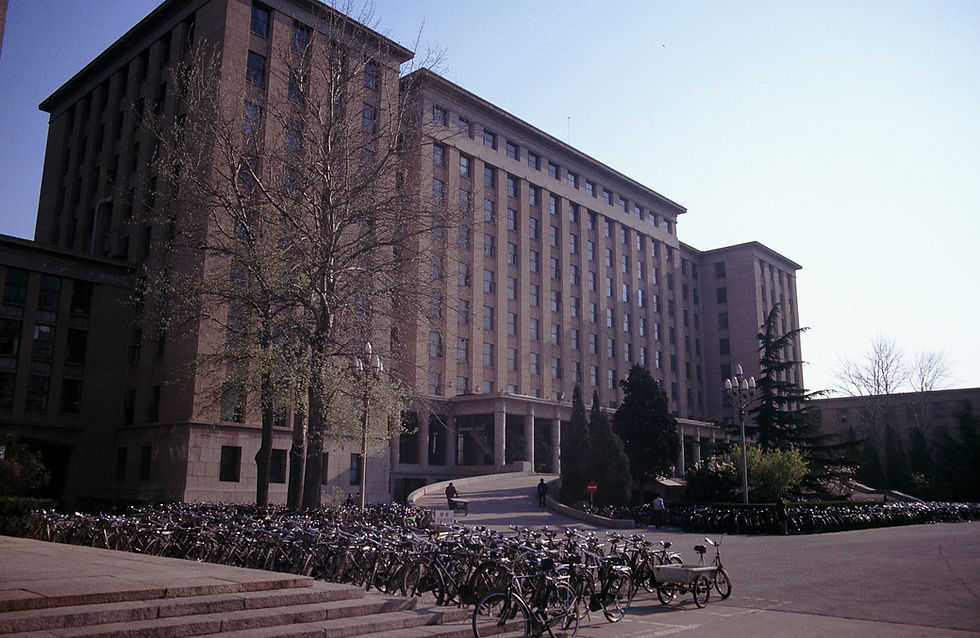
Architecture Department, 1991, photo by Johan Nilsson
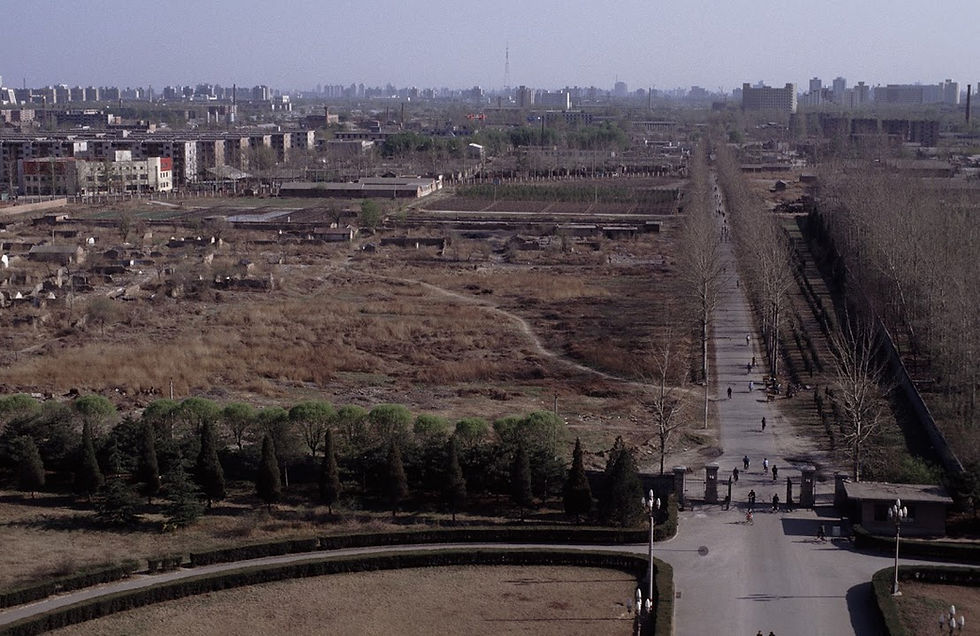
Picture from the Architecture Department facing south, 1991, photo by Johan Nilsson
I walked to a ten-story building. The Architecture Department was on the eighth floor. Guo Yi Lan told me about their exchange programs with MIT and Penn State. It included a lecture series for artists, architects, and planners. She said her father encouraged her to study; different from the prevailing custom at the time when only sons were encouraged to study. I said I was interested in the implications of the principle of the equality of men and women for design and planning. I hoped I could bring some information about this to China; I have the freedom to move around the world.
Qiu Jiang came by at ten o'clock. We looked at student and professor work displayed in the hall. The first Chairman of the Qinghua department of architecture was Liang Si Cheng (1900-1972). There was a picture of with the famous architects of the day - members of the Board of Design Consultants appointed to plan the construction of the UN permanent headquarters on Manhattan 's East River site.
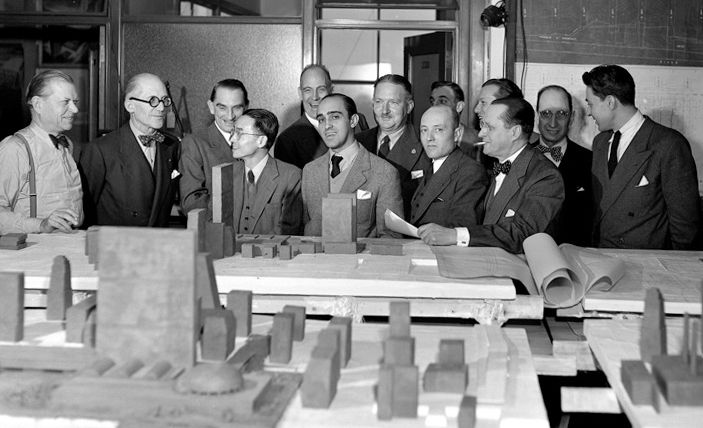
Foreground, left to right: Liang Si Cheng, China; Oscar Niemeyer, Brazil; Nikolai D. Bassov, USSR; and Ernest Cormier, Canada. In second row, from left to right: Sven Markelius, Sweden; Charles E. Le Corbusier, France; Vladimir Bodiansky, France, engineer consultant to Director; Wallace K. Harrison, chief architect, USA; G.A. Soilleux, Australia; Max Abramovitz, USA, Director of Planning; and consultants Ernest Weismann, Yugoslavia; Anthony C. Antoniades, Greece, and Matthew Nowicki, Poland. New York, 18 April 1947.
We went to Qiu Jiang's studio. He was working on a housing development for offshore oil workers on Huang Dao (Yellow Island) near Qingdao in Shan Dong Province. I saw a book I would like to get, "A brief history of ancient Chinese city planning" by Wu Liang Yong.
I had lunch with Qiu Jiang in his room. He went to the dining hall, where they cook it just after you order it. He had student meal tickets. His girlfriend, Mei, came.
We walked to Yuan Ming Yuan Park (The Old Summer Palace) just to the west of the campus. Its construction began in 1709. It was burned and looted by British and French forces in 1860.
After lunch a car from the Beijing Design Institute was waiting for us. The architect, Wang Hui was in the car. Qiu Jiang came with us. At the institute we entered a beautiful meeting room with about ten women architects; designers of schools, hospitals, hotels - including the Peace Hotel near the Forbidden City. I was given a slide show. They had an official translator.
Their organization has about one hundred members and had recently held a five-day exhibition of their work. They wanted connection with other women architect groups. They wanted justice on the domestic front; to have a career and do all the housework was unfair. When our meeting ended I was taken in the car to the railway station. Qiu Jiang came all the way to the station gate with me. He then had to ride buses for an hour and a half back to the university. He would miss his supper. Today I was given royal treatment.

Jian Bing Guozi
Back in Tianjin the dining hall was closed, so I decided to go on my bicycle to buy some Jian Bing Guozi, a delicious Tianjin street food. The vendor was on the plaza near the student dining hall. The plaza was sunken about a half meter. In the darkness I sailed over the change in level and crashed on the ground face first. Someone helped me to get up and took me to the hospital. Three stitches.
November 12
I taught the Architectural English class with a big white bandage on my head and one bright red mercurochrome eye. Later in my room, Professor Jin Qi Min came by to make sure I was alright. He told the Foreign Affairs Office they will not have to pay for my airfare. They said that helps. Now they can say to other departments that the architecture department is contributing to the expenses of their foreign teacher. He knows how to negotiate. He is also looking for money to pay the transportation expenses so ten of the departments students can go to Germany. Professor Sprungala has offered to accommodate them for six weeks in Aachen. Professor Jin said he thought the work of my students was very good. Qiu Kang dropped by with some oranges for me; he hopes I get well soon. He told me Qinghua University, Beijing University, and Hefei University get first pick of students, based on their entrance university examination results. Tianjin University is in the second tier of "pickers".
November 14
Third year studio. The second project of the term begins. I gave Professor Jin an article in English about the Fragrant Hills hotel. I meet my new group of third year students. We will design the second project of the term, a hotel in Guiling. Dong Qing and Yu Xue Mei came to thank me for teaching them. I still feel slow and groggy from my bicycle accident.
November 16
He Jian Qing came to visit. We had a great talk about the emotional life of small versus larger cities. She is studying Zheng Zhou, a small city. Her grandparents are from this area. Yu Guo June dropped by. He is the Good Sanaritan who helped me after my accident. He came to see how I am. He sleeps in his office and spends the day in is room on the campus. His work unit has not found a room for him yet. I went to Food Street with Nick and Harry to have hot pot. A Canadian doctor dropped by, Darius Akhavan. He is in China for a few weeks.
November 17
Go to hospital to get stitches out. Worked on my Canadian International Development Agency Housing Research application. Fan Wei and Lan Jian (Jack) dropped by to borrow books and music. Jack gave me some wonderful apricot candies. Lucky wedding candy.
November 18
Sheng Kai said he's leaving for New York in mid-December. I'm happy for him, but I will miss him. I organized six more lectures for Architectural English.
November 19
I went to the studio, but there were only two students. Someone told me everyone was at a meeting with the mayor about the new railway station. I went to the copy center with my material for the six Architectural English lessons. The Architecture Department has no money to cover printing costs. The copy center was closed. I forgot, on Wednesday afternoons there is no power. Energy rationing.
I met He Jian Qing again. She's working on her Zheng Zhou planning research on the sixth floor. We found we have strong agreement about underlying social-spiritual principles. It was a fast and exhilarating conversation.
Qiu Kang and I put a notice in the School of Architecture lobby inviting students to make measured drawings of 10 housing developments, mostly in the Foreign Concessions.
November 20 I went to the hospital to check on my eye, now yellow and purple. The doctor said I damaged the sheath over the bone. Blood is under it, causing a lump to hang over my eye. It's not too large and doesn't affect my site. I spent twenty-five Yuan at the copy center for materials for the Architectural English class. Qiu Kang came by. We planned our slide show for Saturday night (November 22) for our 'short research project' about Tianjin Concession housing. We will invite the students to do measured drawings. I helped him with an application letter to Columbia University. Carry said he has been up until one in the morning for weeks working on the railway station competition. I met Xu Subin at the copy center. A social psychologist at Beijing University has agreed to read a draft of her thesis. Exciting! She is looking for help outside the world of architecture. She was wearing a beautiful pink Chinese jacket quilted with a faint silver thread.
Attendance has dropped at our foreign teacher's Chinese lessons. It's just me and Andrea.
I reviewed the Guilin hotel project to prepare for tomorrow morning's design studio. November 21 In the studio I asked the students to think carefully about 'borrowing' the adjacent mountain scenery in their design. This is a brilliant Chinese concept where the foreground is designed with the background in mind. When they lay out their buildings and gardens to incorporate distant peaks as part of the layered view looking out from their site. The distinctive karst hills around Guilin are ideal for this. I had read about this when I was in Newfoundland. I especially liked a Chinese garden that was designed with a small pavilion from which to view the full moon. The designer had 'borrowed the moon'! I borrowed it as well for a night time performance called Sitelines in the Harbour of St. John's.
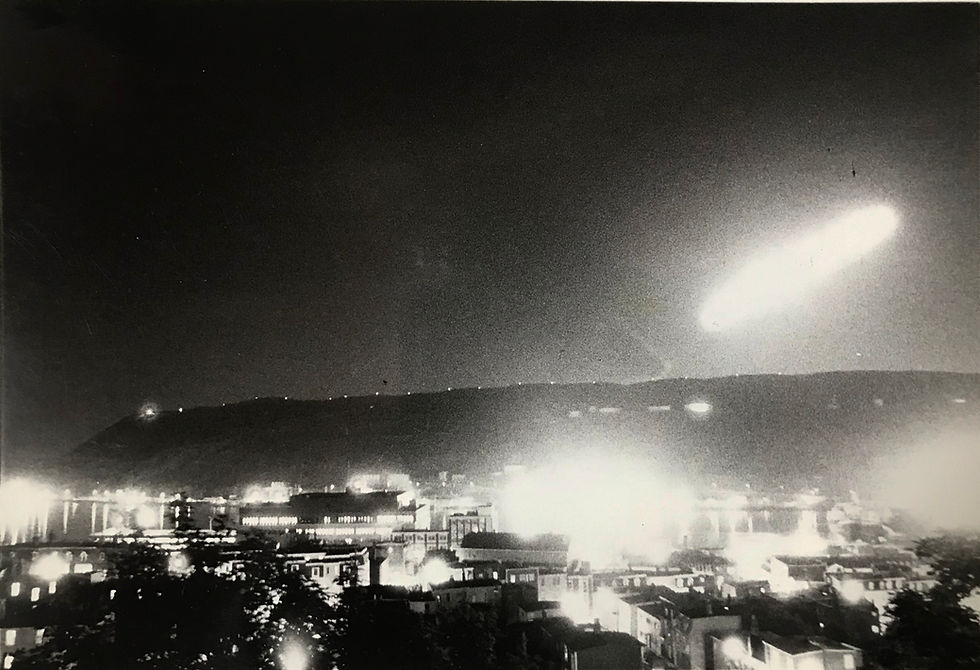
Sitelines, St. John's Newfoundland, Canada
P.M. Qiu Kang came by and we prepared our slide show for tomorrow night about Tianjin housing. We got on our bicycles and rehearsed the route of our planned tour on November 23. That evening I designed a not-so-Hyatt, a six-storey version that clung to the edges of the site instead of a tower in the middle. November 22 Yesterday I was resisting tall buildings; today I'm helping Qiu Kang with his TV and Radio tower design. After supper we presented slides about Tianjin Concession Area housing. Twenty students came. How many will come tomorrow morning for the bicycle tour? November 23 I felt a fever early in the morning. Had a hot soak in my long tub before going out. At 8:30 in the morning I went to Building 19 (our studios). Twenty students, mostly, from third year were there ready to go! Seventeen girls, three boys.

Students who signed up for the project
Qiu Kang and I led them on a bicycle tour of the selected projects. This was a good response because the student workload is not light and this activity was only to learn, not for credit. The ten sites to be measured included two in the old Chinese city, Yuan Shi Kai’s former residence in the Austro-Hungarian Concession, two in the Italian Concession and five in the British Concession.
I had been to all of the sites before except for an unusual dwelling in the Italian Concession. It was unusual, a two-story courtyard house with a glass roof, built in the early 1900s. Typically, what was once the home of one family was now occupied by many; each of the major rooms was a family home. Curtains hung from the ceiling were the only privacy between the generations. The courtyard that used to be private was now shared by several families. As we filtered in with our sketch books and cameras, the people watched us closely and simply asked what we were doing; we were not thrown out.
There was an especially beautiful example of row housing in the British Concession located on Ma Chang Dao (Horse Racecourse Road). This road, the southern boundary of the British Concession. led to the Race Course just outside the Concession Area - at that time, out in countryside. The housing was designed as a terrace, ten dwellings long. A more typical way to design row housing is to put them in pairs. From the street, the elevation of one row house is the mirror image of its neighbor. Pairs of doors appear on either side of the mitoyen wall dividing two units.
The architect, a Frenchman who somehow had a commission in the British Concession, placed six units in the middle with a higher roofline flanked by a pairs of slightly lower houses on either end. The third floor windows, both in the center block and in the wings on either side, are linked together in a horizontal line. This obscured the separateness of the houses and augmenting their unity. St. John’s, Newfoundland, had terraces three and five houses long, but none of them reached ten. Giving the ten-house “block” a sense of a whole may seem unnecessary on a narrow street. Two of these ten-house blocks were looking at each other across a street that was only 20 meters wide. Although this “wholeness” is not easily seen in its grand totality, you can sense it even from an oblique view. It adds another layer of interest to an otherwise simpler street façade. I am sympathetic to a design that explores the relationship between parts and wholes and suggests the whole is greater than the sum of the parts.
While we were looking at the Ma Chang Dao housing in the former British Concession, I stayed behind taking pictures. A group of children came over and danced around me in a circle, shouting, “Wai guo ren! Wai guo ren!”. Literally, “Outside Country Person! Outside Country Person!”, or “Foreigner! Foreigner!” Temporarily, my spirit drooped.
Driving back on my bicycle, I saw cabbage for sale, in huge mounds on the sidewalks. It had been brought there during the night by farmers on horse-drawn carts. In one winter, a family uses about 200 jin. One hundred jin cost 3 yuan.
I wonder if I will have a contract to work here after Spring Festival (1987).
Dong Qing told me about an exhibition of Chinese housing and urban development in Beijing. A group of students invited me to come along with them. The exhibition was in two weeks. I didn't know it at the time but this was step one in a process that allowed me to have a life in China. I wish I could find her and thank her.
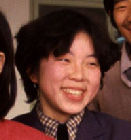
Dong Qing
November 24 After our tour, groups of students each took one of the ten housing sites. On their own time they would return to take measurements. They used these to draw plans, elevations and sections. If they did all that, my plan was to print their work and give every participant a book that contained all the work of all the students; a reward for participating. The quality of work was uneven so, later, Xu Su Bin and l finished some of the drawings and unified the graphics. Samples of the work is shown below.
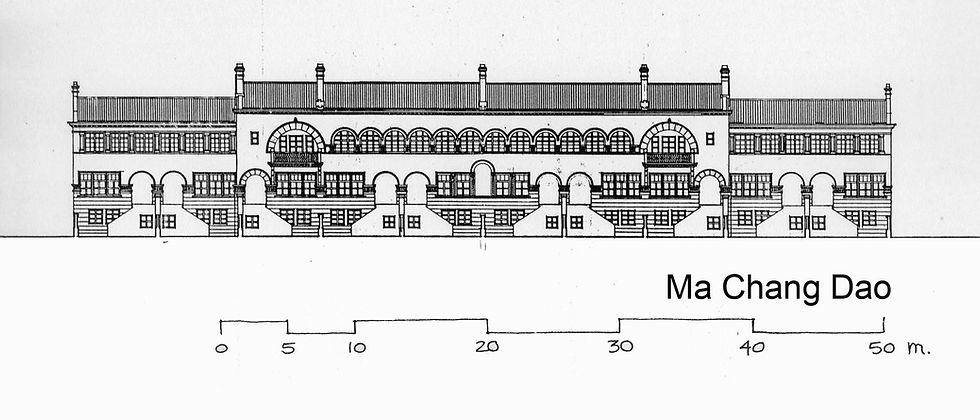
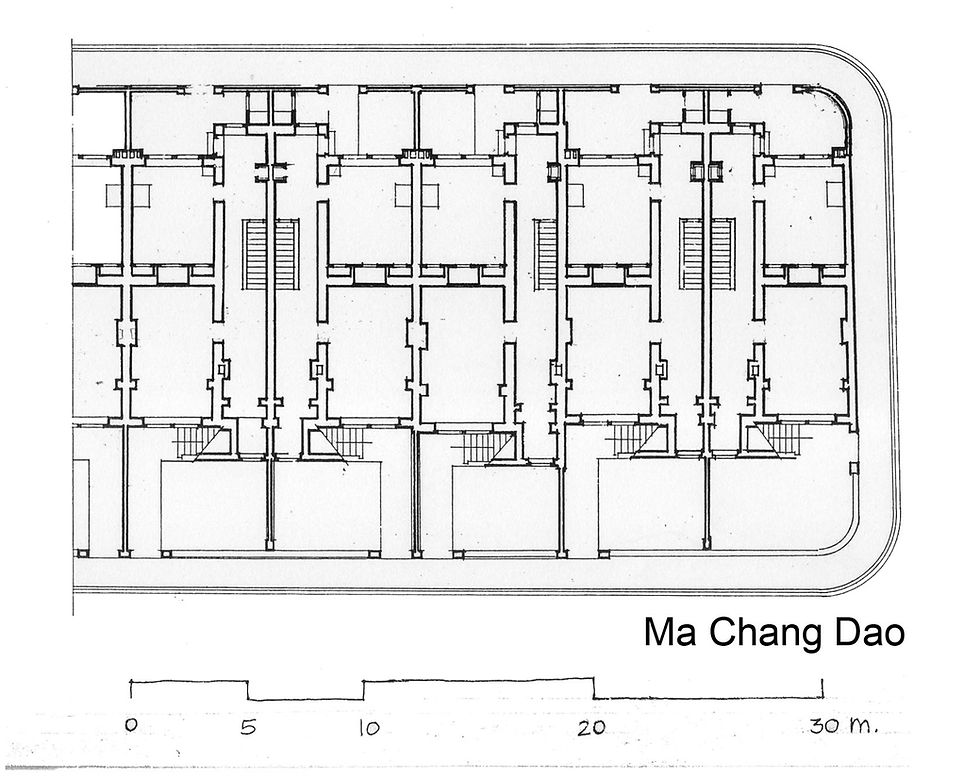
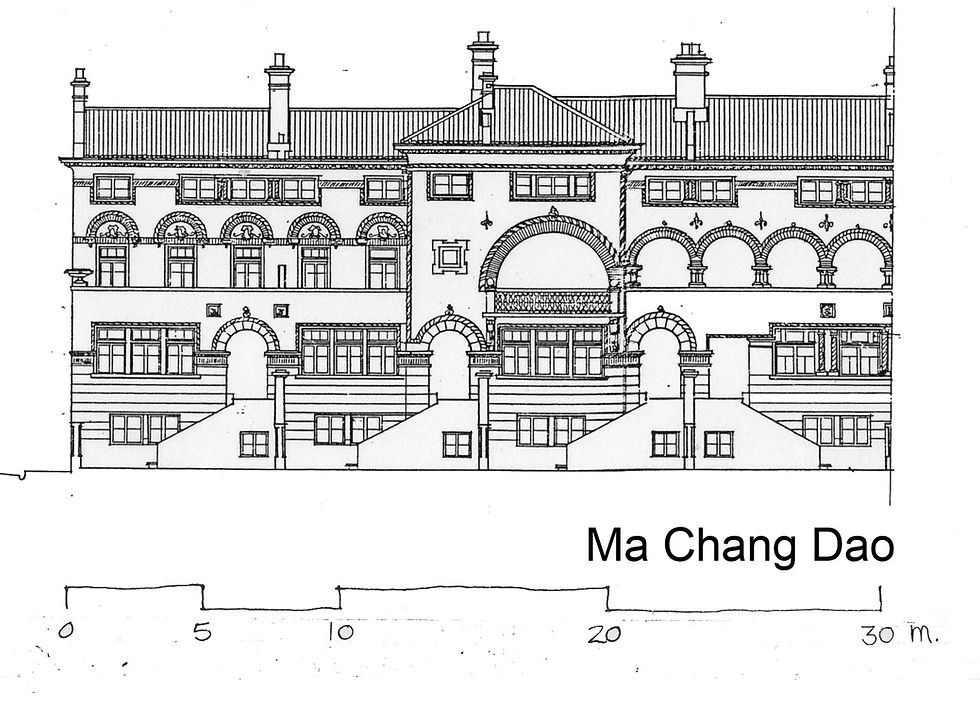

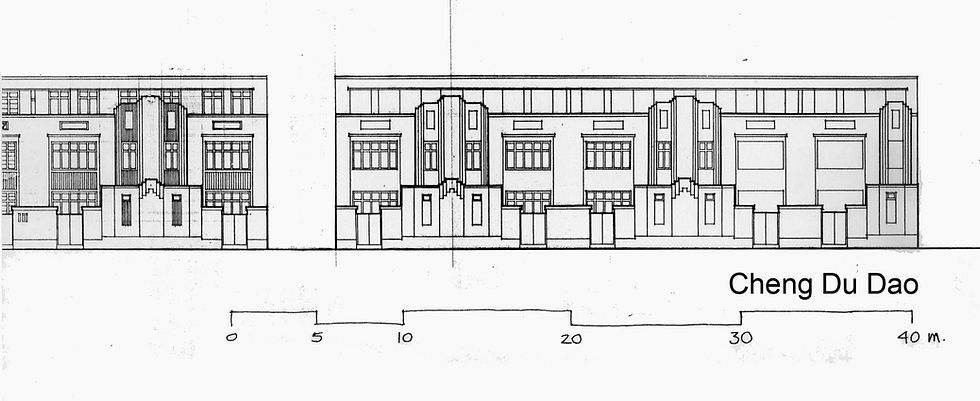
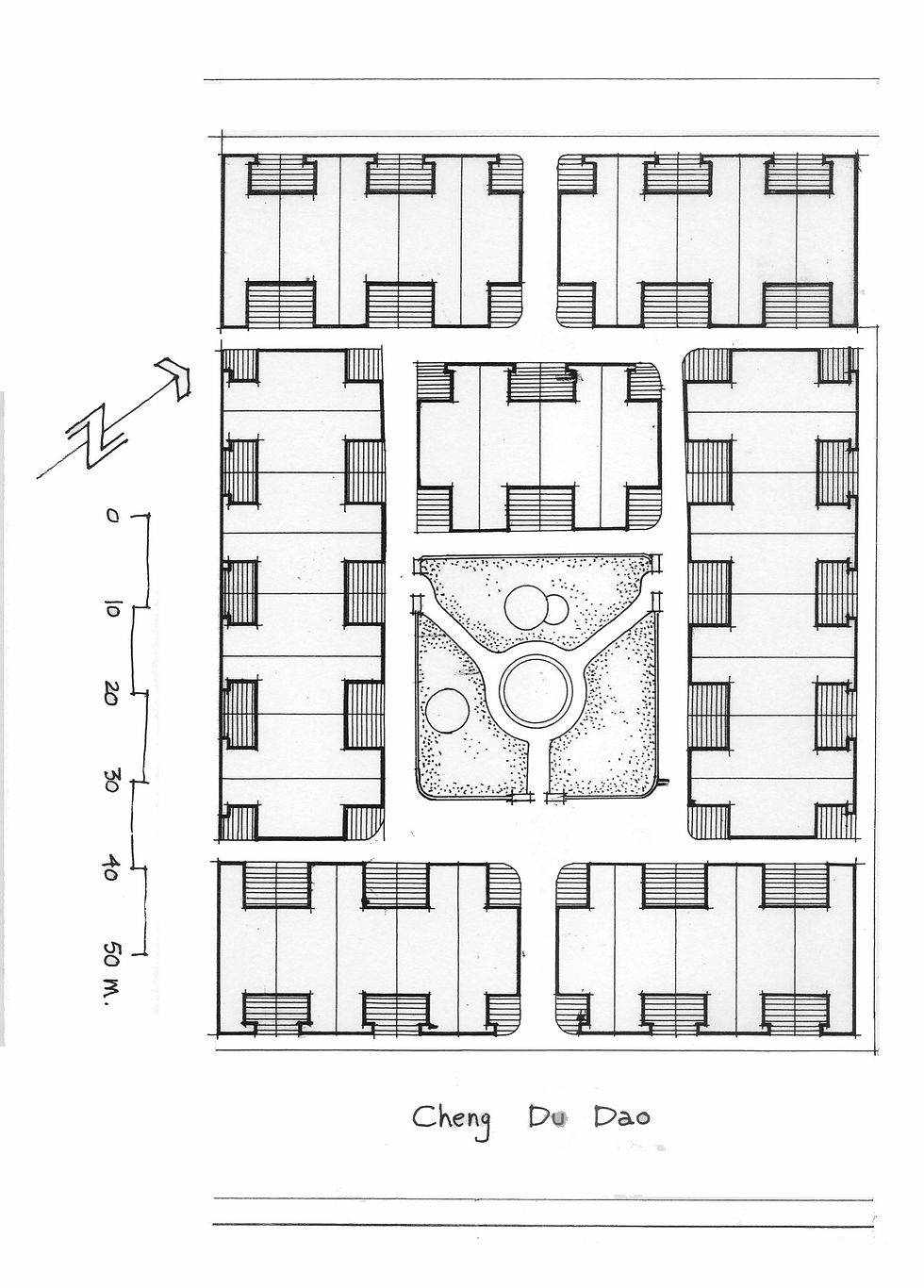
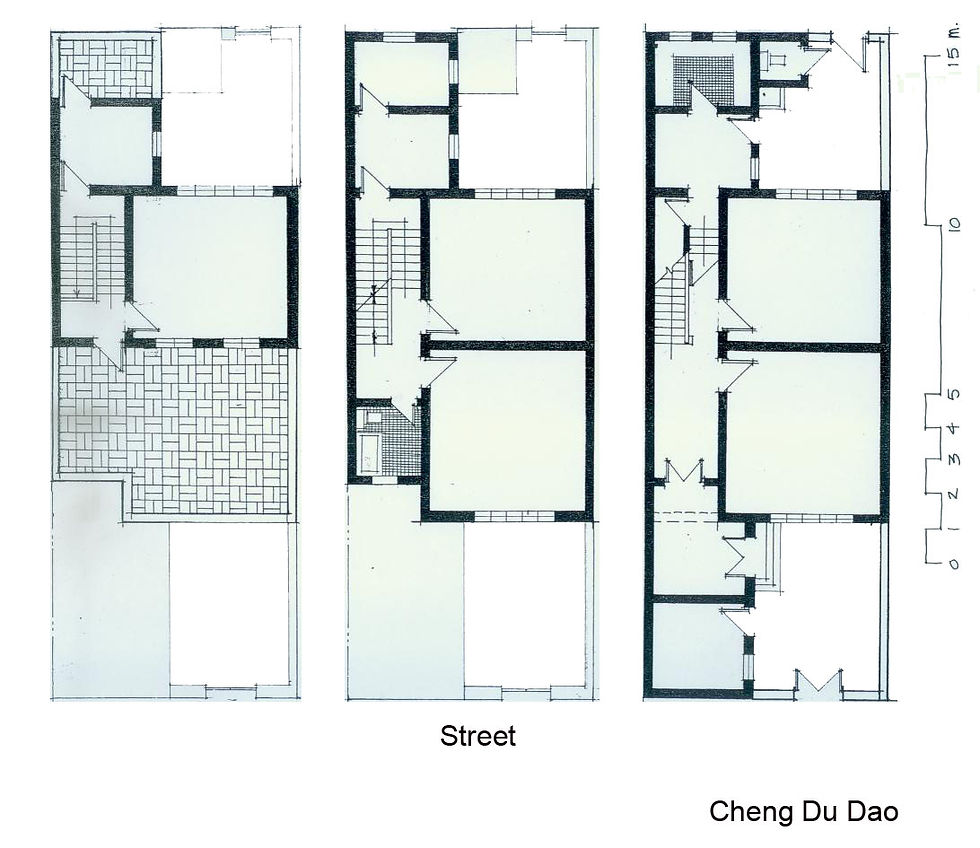
* * *
I saw a movie called Hibiscus Town (Fu Rong Zhen). One of my graduate student friends translated some of it quietly beside me. It was about a village in southern China. "Hibiscus Town (Fúróng zhèn) is a 1986 Chinese film directed by Xie Jin, based on a novel by the same name written by Gu Hua. The film follows the life and travails of a young woman who lives through the turmoil of the Cultural Revolution and as such is an example of the 'scar drama' genre that emerged in the 1980s and 1990s that detailed life during that period." It was shown at the “Seek Truth from Facts” Theater on campus.
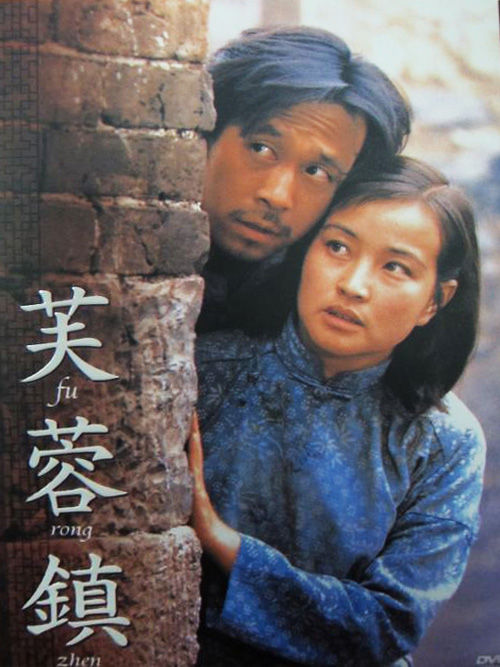
* * *
Late November was the time to buy a few Christmas gifts for my parents and brothers in Ottawa. I went to the new shopping center called the International Market that had opened up in front of the French Catholic Church on Nanjing Road. In 1985, the church was still facing a generous plaza; the church and plaza were the southern climax of the long Bin Xiang Dao Market Street. Now the plaza size had been much reduced, and the axial view of the church constricted by the International Market.
In the days of the French Concession, the street was called Rue du Marechal Foch [Ferdinand Foch (2 October 1851 – 20 March 1929) was a French general and military theorist who served as the Supreme Allied Commander during the First World War. An aggressive, even reckless commander at the First Marne, Flanders, and Artois campaigns of 1914–1916, Foch became the Allied Commander-in-Chief in late March 1918 in the face of the all-out German spring offensive, which pushed the Allies back using fresh soldiers and new tactics that trenches could not contain. He successfully coordinated the French, British and American efforts into a coherent whole, deftly handling his strategic reserves. He stopped the German offensive and launched a war-winning counterattack. In November 1918, Marshal Foch accepted the German cessation of hostilities and was present at the armistice of 11 November 1918".

Partial Map of Tianjin 1931
At the center of the red circle on the map above is the French Catholic Church. It is on the axis of Rue du Marechal Foch. The blue colour indicates the French Concession, green the British and orange the Japanese. The two bright green squares in front of the church are the site of the International Market built in late 1985 and early 1986.
I finished buying my gifts, and stepped out into the now-smaller plaza, heading for the bicycle parking lot. A large number of people had formed a circle in front of the church, focused on something on the ground. A thick circular audience, silently assembled, on the axis, before the door of God’s home. The ring of people was too deep for me to see what was in the center; I had to wait. Slowly a large, dark, soft form started to bulge over their heads. There was a purring sound, like a motor. A huge dark bag was unfolding, climbing higher and higher until a grand cylinder, eight meters high, erected itself, protruding stiffly out of the circle, an icon standing proudly in front of the church. The people applauded; it was a giant jar of Nescafe instant coffee. A second wave of foreign intrusion.
A few days later at the international post office, Xu Su Bin helped me send my Christmas gifts to Ottawa. The customs forms were all in Chinese and French. The customs people had to see what was in every package. Christmas wrapping had to be done in the post office after the items were inspected. We put the wrapped gifts in a larger box which Xu Su Bin bound in cloth and sewed up. She had come prepared with cloth, needle and thread.
* * *
November 25
These days. Any spare time I have is used to study Chinese.
November 26
Zhang Chi’s team has won the railway station design competition. They were talking about opening an office in Tianjin.Nearly all design work in China is done by government offices. Their’s would be the first private firm in Tianjin. There are two such firms in Beijing.
Architectural English. The topic was about male and female approaches to life and design, based on an article called “Gyn-Ecology” from an Ekistics magazine,1985. I think they found it a bit too theoretical. I left the class feeling a little disappointed. I don’t get a lot of feedback. I feel a little insecure; perhaps I want feedback too much.
Last night, Professor Zhou Zushi took my prepared sheets for each lecture,and reduced them in size to save money.He had spent hours looking up words and adding a small dictionary for each lesson. This is wonderful feedback and support. Then a student Cai Chao said she and the others are grateful for my help.
Evening
Two students Jin Lichang and Cui Honglin dropped by to talk about their designs.
November 27
Work on materials for Architectural English. Work on my CIDA application.
Evening. I need extra work and income; I cant go on like this at Tianjin University in such a tenuous condition. I went to the new Hyatt Hotel with other foreign teachers for an American Thanksgiving dinner. We invited Chen Laoshi to join us. I ate a salad with creamy dressing. Soon I started to feel sick. I raced home on my bicycle and made it to my bathroom in time to evacuate my body from both ends.
November 28
Clean up mess in bathroom. Go to studio for a short time.
PM: Xu Subin came by. We went through her thesis. It was interesting, but I was not feeling well.
November 29
AM Work on Architural English lecture about the Frangrant Hills Hotel deigned by I.M. Pei.
PM I went with students to look at two of the Concession housing sites to talk about what work they should do.
Evening. Potluck supper at Nick and Andrea's. Darius was there.
November 30
Architectural English. Prepare lecture about housing design by Bao Jia Sheng.
Sheng Kai came to say goodbye. He will be gone in two weeks to New York City. Tiny Vachionne is helping him.
December 1
More work on architectural English. I wish my materials could become a textbook. Qiu Kang said he had not met his Concession Housing groups. He was very busy trying to get to America. I felt disappointed.
Work on my CIDA proposal. Do another draft.
Susan (Xu Xin Fang) from the Foreign Affairs Office came by to tell me my contract has been renewed for the next term. I'll be here at least until July 1987. I'm so happy. I went out to the food store on campus to celebrate with snacks. December 2 Third year hotel design is slowly coming; two and three story buildings surround gardens and ponds. One of the students told me about the exhibition in Beijing. She said all the provinces in China participated except Taiwan. Chinese lesson with Chen Laoshi at four o'clock. December 3 I was offered work teaching English, off campus, for twenty yuan per hour.
Architectural English: The topic was "Cities as infrastructure of a global village". For part of the class I tried to have a Spelling Bee. Everyone was very reluctant to leave their seats and stand against the wall.If a student had a hard time spelling a word there were many whispering helpers. I moved around the room to be close to the person spelling to quell the secret assistance. If the student spelled a word incorrectly, he or she had to sit down. There were some very good spellers. After a while, I found that no-one had sat down. They had managed to ensure none of them suffered that humiliation. I had encountered Chinese togetherness and solidarity. One young woman told me after the class that I was speaking below their level of listening comprehension. Their listening and reading comprehension is much higher than their speaking ability. They lack opportunities to practice. Feedback! If I did this class again I would ask them to make presentations. December 4 I told the Foreign Affairs Office I want to join the planned holiday trip for foreign teachers to the south of China at Spring Festival. I drafted a letter to Margaret Kennedy author of Gyn-Ecology. I hoped she could help me with my CIDA research project. Met with students working on the Concession housing measured drawing project.
* * *
I knew I wanted to stay in China. However, other than English teachers, it was rare for a foreigner to become a long-term employee of a university in China. I had to find a way to stay. I sent an application to CIDA in Ottawa for a two-year research grant, starting in the summer of 1987. I proposed researching housing policy and finance, and citizen participation. I would do the research with China’s needs in mind and submit the results to the Chinese Ministry of Construction for use in their efforts at Housing Reform. Specifically, I proposed one year of background reading, and studying Chinese, followed by a second year of site visits to a few places around the world where citizen participation in housing was practiced. I would prepare a summary report mostly in the form of a compilation. December 7 I took an early train to Beijing with my students to see an Beijing Urban Planning Exhibition They bought my ticket and we rode hard seat together. The first thing you do when you arrived at your destination is to buy your ticket home. I went to the soft seat ticket office and bought my evening ticket to Tianjin. The students bought hard seat tickets. We took the subway to the Beijing Exhibition Center, near the Beijing Zoo. This Center, a Russian-influenced design, was one of the ten major projects built in 1959 to commemorate the tenth anniversary of the founding of the PRC. The exhibition was mainly large plastic models of planned expansions of various cities around China. A large, central symbolic model showed a vision of the future city as a dense mass of skyscrapers. There was a wall-hung aerial photo of Beijing about 4 x 4 meters square. I studied it for a long time, but was not allowed to photograph it.
A Chinese man came up to me and, in very good English, apologized that all the signs on the models were in Chinese. He accompanied me for a while, explaining things, and he found out what I was doing in China. We said goodbye, but after a while I thought, “I want to stay in touch with this man.” I ran around looking for him, found him, and we exchanged addresses. I learned he was Sun Hua Sheng, a senior planner with the Ministry of Construction. I offered to come to Beijing sometime and show my St. John’s slide show. He welcomed that. This, in hindsight, was step two in a process that opened doors for me to stay in China.

Sun Huasheng
After a day struggling in my beginner’s Chinese, I was exhausted. On the way back to Tianjin, I happily buried myself in my soft, wide, doily-backed chair, and an English book. As I stepped off the train in Tianjin, the students were all there asking me, with concern on their faces, “Were you lonely?”
* * *
Meal times with the other foreigners in the Dining Hall were good language breaks and networking sessions. Connection with the outside world was limited. Many foreigners listened to BBC Radio and the Voice of America. If someone went to one of the few international hotels and bought an imported newspaper or magazine, it was circulated among us until everyone read it. We swapped “intelligence” on where to get bicycles fixed, which hotel had good coffee, or how to mail packages at the post office.
I came back to the Guest House one day, and a group of them bounded out the door dressed as Virginia Hillbillies. They had organized a Halloween Party for their students. I guess the Chinese students would be amused. It was fine the foreigners were sharing their culture; but it felt like they had never left home. It seemed to me their teach-and-give mode was stronger than their learn-and-receive mode. Most of them were Christian missionaries wanting to reach China with their message. They were so keen to share their truth, I suspected it overwhelmed the message China had for them. I struggled with this because I too had a religion.
Note from 2021: Years later, my Chinese wife would accuse me of the same thing. “Joe, you did not come to learn and receive from China; you came here to teach and give ‘your superior message’!” Other foreigners were in China from curiosity, for the experience. They were more vulnerable to the impact of China, and the contact was more interactive. Their challenge was to avoid succumbing to a habit of complaint about China; the university administration, the management of the Guest House, the quality of public washrooms, spitting, etc. Once, at a social evening, we showed each other slides we had taken in China. I included one, a diagram showing the commonality of the axes in the architectures of different civilizations, including China. “What is this, a lecture?” one of them said. He showed his collection of slides of Chinese people sleeping outside or on trains, sometimes in funny positions - one man using his metal lunch box as a pillow. In a big western hotel in Beijing, I once saw a foreign woman ask for something at the front desk. She was for something in English, and the Chinese person trying to help her did not understand. She repeated her question in a louder, more impatient voice and still the receptionist was unable to respond. Infuriated, the guest shouted even louder and slowly enunciated every word, as though full comprehension would be the result. Living in Newfoundland for eleven years was a good preparation for coming to China. We who were not from there were referred to as “Mainlanders”, “Come-from-aways”, and were asked, “Ye don’t belong here do ye?” It took wit, patience, and an attraction to differences to get over these hurdles and discover the kindness, humor, talent, and beauty that was there in abundance. In China, the scale of the culture-meets-culture challenge was larger, but the process was the same.
Bình luận